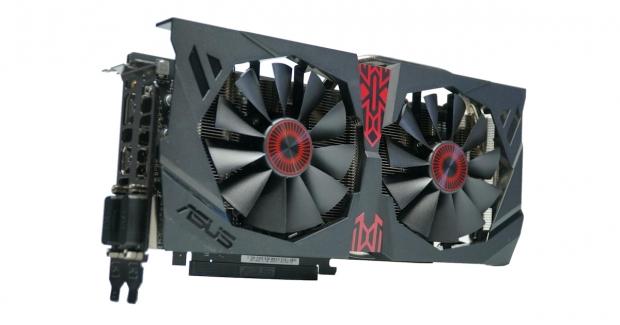
The Bottom Line
Introduction, Quick Specs, and Availability & Price
AMD has launched its new Radeon R9 380X after countless rumors on a new mid-range GPU being launched, the Antigua XT-powered card is real. AMD is marketing the new R9 380X at 1080p and 1440p gaming, with our first sample off the bat being from ASUS in the form of the Radeon R9 380X STRIX.
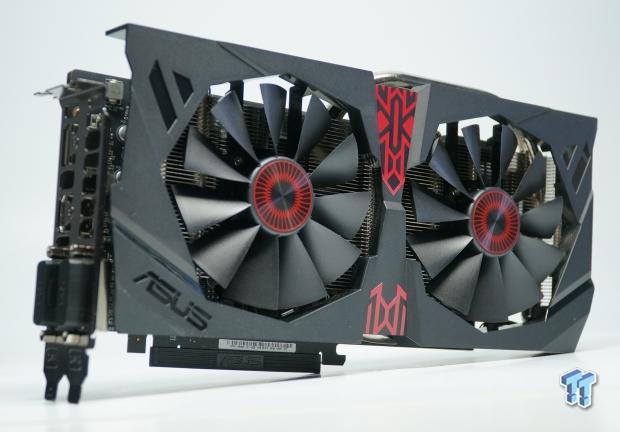
We covered the Radeon R9 380X in detail in our launch article, but we'll refresh you on technical specifications soon. As for the ASUS Radeon R9 380X STRIX we have here today, most enthusiasts will recognize the STRIX branding as the latest in the gaming push from ASUS.
The STRIX branding from ASUS teases that the R9 380X STRIX is 20% cooler, and allows for silent gaming. ASUS uses premium components for its video cards, with the company deploying its 'Super Alloy Power' components onto the R9 380X STRIX that help "boost performance by reducing power loss, enhancing durability and achieving cooler operation".
Quick Specs
AMD's reference specifications for the Radeon R9 380X have it including 128 TMUs, 32 ROPs, and 32 Compute Units. We have 4GB of GDDR5 spread out on a 256-bit memory bus, with 190W of power required.
Availability & Price
We should find the ASUS Radeon R9 380X STRIX for around $239, depending on how many cards the local retailers and e-tailers have at launch. The reference board is priced at $229, with board partners kicking off their pricing on the R9 380X at $239.
The Radeon R9 380X has 2048 shader cores, down from the 2560 on the R9 390X and up from the 1792 on the R9 285.
Detailed Look
ASUS has put its Radeon R9 380X STRIX inside of a great looking box that will catch the eyes of consumers while it sits on shelves.

The front of the box looks fierce, with a Transformers-like robot on the front. To the right, we can see this is the STRIX Gaming brand, and in the bottom right - there's no surprise, this is the Radeon R9 380X.
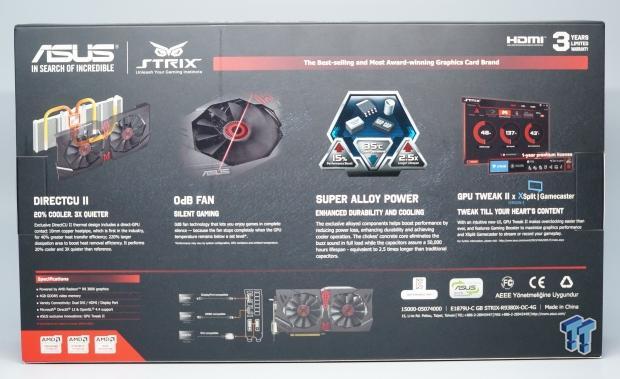
On the back of the box, we see that it has the DirectCU II cooler, a 0dB fan, Super Alloy Power and some software in the form of GPU Tweak II.
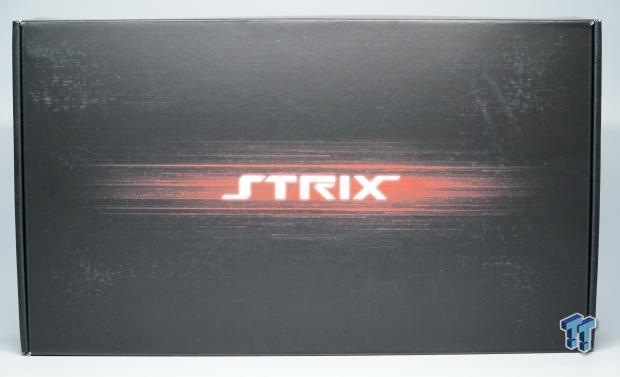
Inside, the R9 380X STRIX is protected by another mean-looking box.
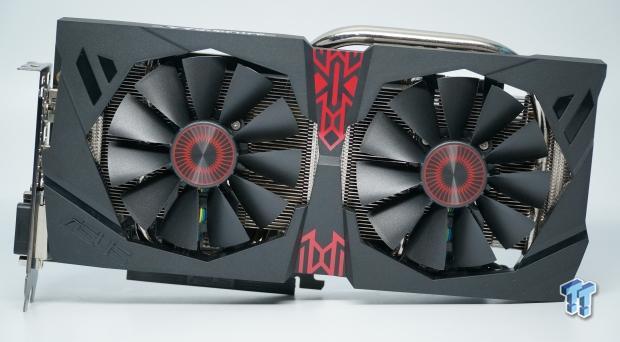
Here we have the front of the ASUS Radeon R9 380X STRIX.
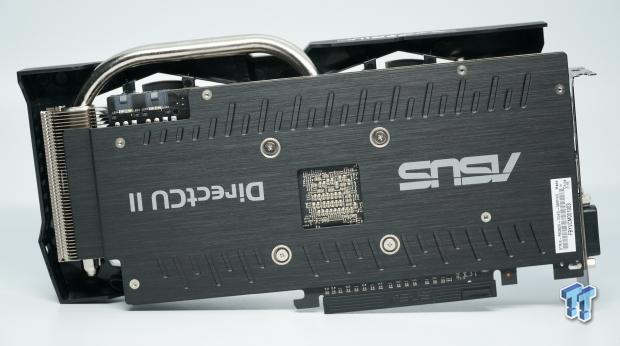
And once again, from the back.
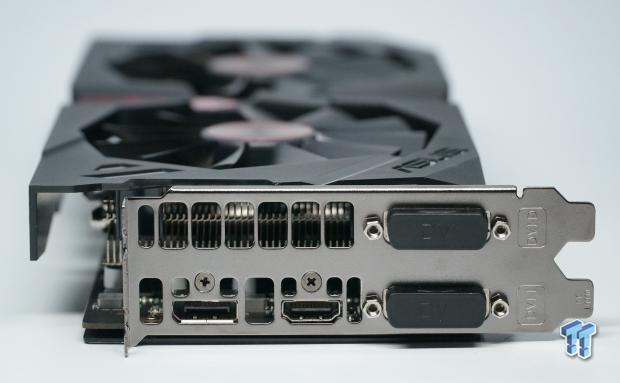
ASUS has provided 1 x DisplayPort, 1 x HDMI and 2 x DVI ports for display connectivity.
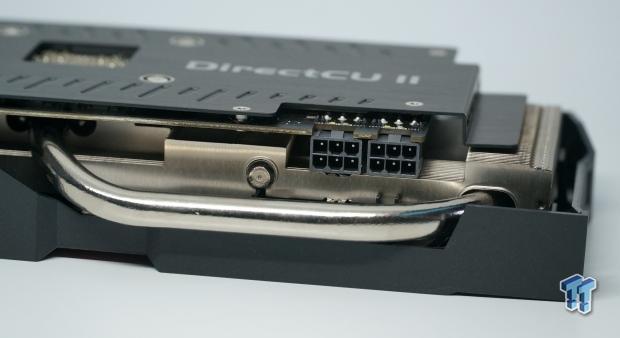
You'll need 2 x 6-pin PCIe power connectors to power the R9 380X STRIX.
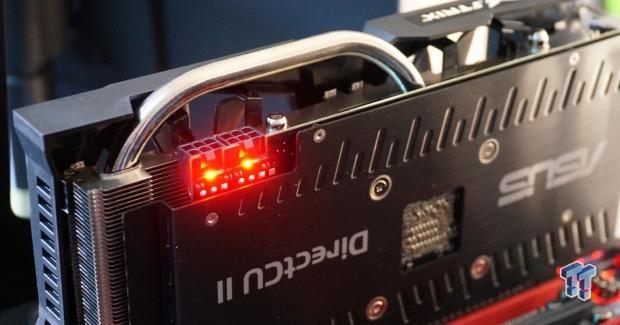
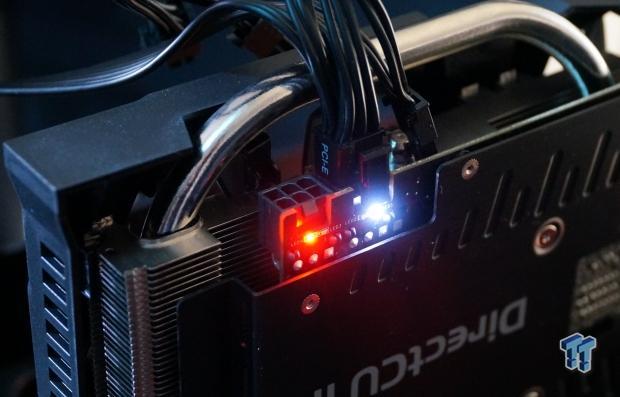
There's definitely something I love from ASUS on the R9 380X STRIX before I even turned my system on, and that's the power LED lights. There are two lights that turn red when there's no power plugged into the card, and then white when everything is A-OK.
Card Specifications & Cooling Setup
Card Specifications
The Radeon R9 380X is a mid-range card aimed at 1080p gamers, with 1440p gaming in its sights if you don't want to game at 60FPS. ASUS hasn't changed much on its R9 380X STRIX, but we do have a better cooler and some overclocking potential with this card.
The ASUS Radeon R9 380X STRIX has the same 128 TMUs, 32 Compute Units, and 32 ROPS as the reference card. We have the same display connectivity as the reference design from AMD, too.
Cooling Setup
The cooling side of the R9 380X STRIX is where ASUS should excel, deploying its DirectCU II cooler that is 20% cooler, and 3x quieter than reference designs.

If we look close, there's a chunky as hell heat sink on the R9 380X STRIX which should keep the GPU, VRAM and VRMs nice and cool.
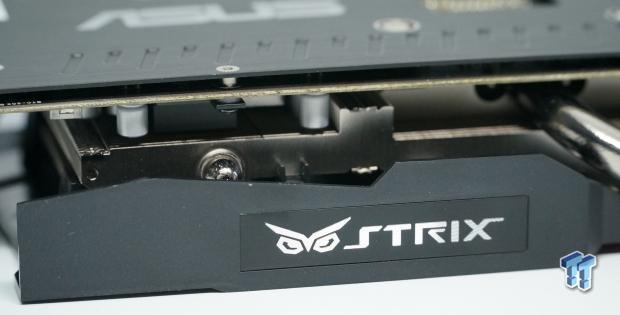
Another look, this time from the front of the card.
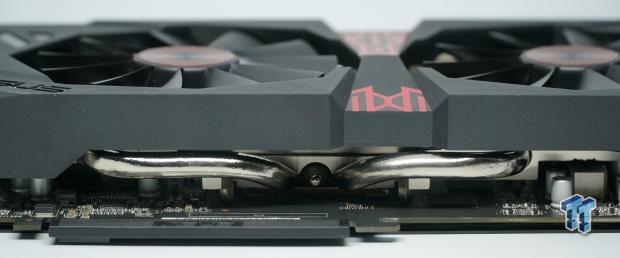
And again from the rear of the R9 380X STRIX, where we can see the heat sink hanging off of the edge.
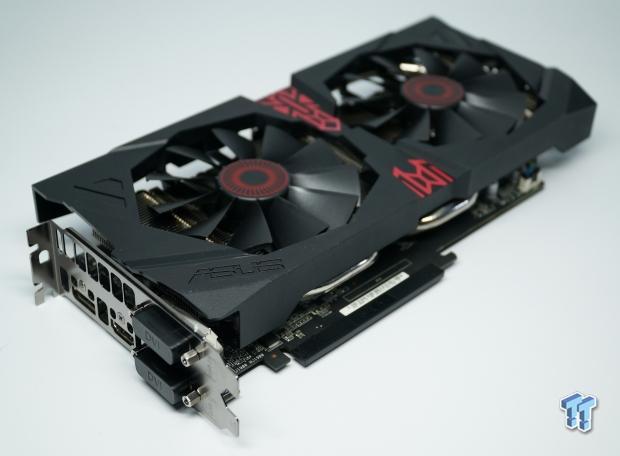
An elaborate heat sink keeps the R9 380X STRIX cool.
Testing Method & Test System Configuration
Testing Method
I've played Battlefield 4 on a 64-player server to provide some real-world performance numbers. I've found this is one of the best ways to provide the most realistic performance numbers, as it involves actual gameplay in a large server that really strains most setups.
For now, I'm going to be using the same suite of benchmarks I've been using on my Tweakipedia articles, which uses a mix of synthetic benchmarks with Futuremark's 3DMark and Unigine Heaven. After that, we have a bunch of titles with built-in benchmarks (which does not represent actual in-game performance) but they are repeatable for you at home to gauge the performance of your PC or GPU.
Over time, I will be adding in new benchmarks and a new section that will concentrate solely on real-time gaming benchmarks. This will take more time per review, as I'll have to invest time into actually physically playing the games, but it'll be worth it in the long run. For now, let's get right into the synthetic benchmarks and see how this video card performs.
Battlefield 4 Testing
This is one game that we did differently, as it does not feature a built-in benchmarking feature. When it comes to Battlefield 4, there are countless ways you can benchmark it. Some find a spot in the single player campaign which is easily repeatable, and use that. For our testing, we've chosen to use a 64-player online multiplayer server for real-time performance statistics.
We joined a 64-player map and played for five minutes using FRAPS, pulling our minimum/average and maximum FPS. We did this for each test, we run the game for 5 minutes at 1080p/1440p and 4K. We are using a custom Ultra preset (disabling AA). It's time consuming, but it gives us a perfect look into true real-world performance.
Test System Configuration
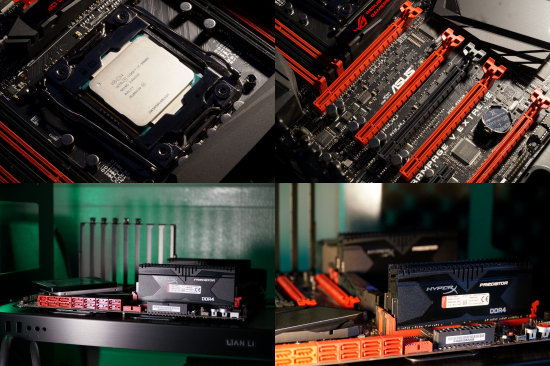
We have another new start for VGA benchmarking adventures, where not only are we adding in 3440x1440 results, but we've also shifted to a high-end Core i7-5960X to remove any potential CPU bottlenecks. Corsair sent us over their kick-ass AX1500i PSU, which provides 1500W of power for our 3- and 4-way GPU testing that we have coming very soon.
Anthony's Video Card Test System Specifications
- Motherboard: ASUS Rampage V Extreme - Buy from Amazon / Read our review
- CPU: Intel Core i7 5960X - Buy from Amazon / Read our review
- Cooler: Corsair H110 - Buy from Amazon / Read our review
- Memory: Kingston 16GB (4x4GB) HyperX Predator DDR4 3000MHz - Buy from Amazon
- Storage #1: SanDisk Extreme II 240GB - Buy from Amazon / Read our review
- Storage #2: Intel 730 Series 480GB - Buy from Amazon / Read our review
- Case: Lian Li PC-T80 Open-Air - Buy from Amazon
- Power Supply: Corsair AX1500i - Buy from Amazon / Read our review
- OS: Microsoft Windows 10 Home 64-bit - Buy from Amazon
- Drivers: NVIDIA GeForce 359.00 WHQL and AMD Catalyst 15.11.1 beta
Benchmarks - Synthetic
3DMark Fire Strike - 1080p
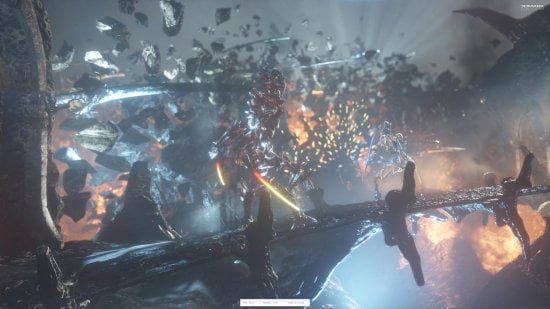
3DMark has been a staple benchmark for years now, all the way back to when The Matrix was released and Futuremark had bullet time inspired benchmarks. 3DMark is the perfect tool to see if your system - most important, your CPU and GPU - is performing as it should. You can search results for your GPU, to see if it falls in line with other systems based on similar hardware.
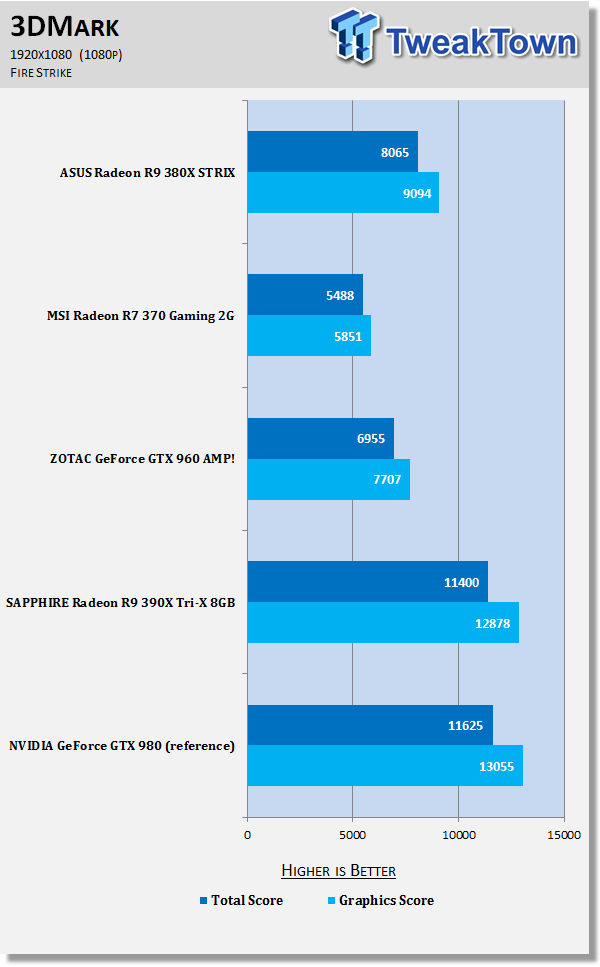
3DMark Fire Strike Extreme - 1440p
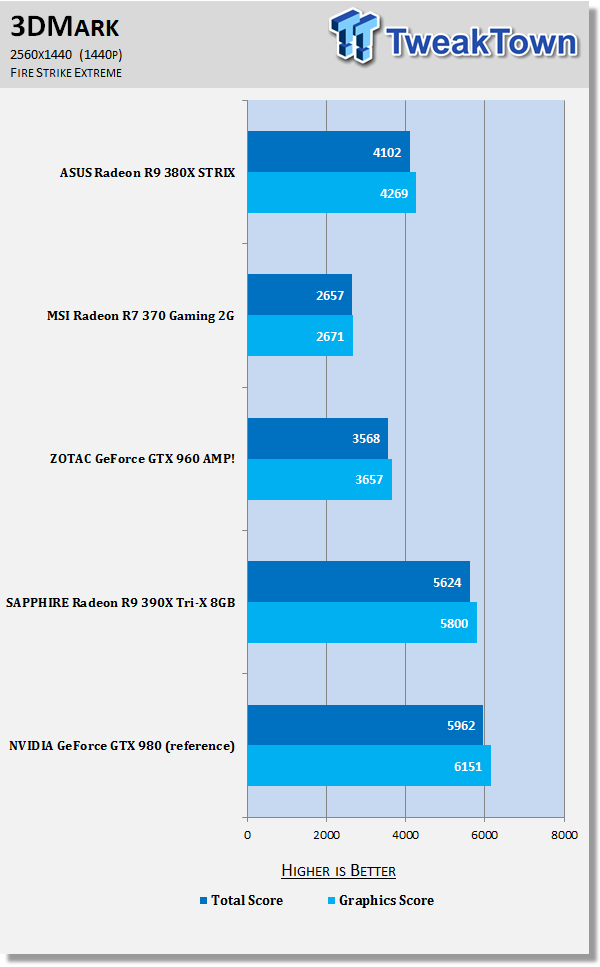
3DMark Fire Strike Ultra - 4K (3840x2160)
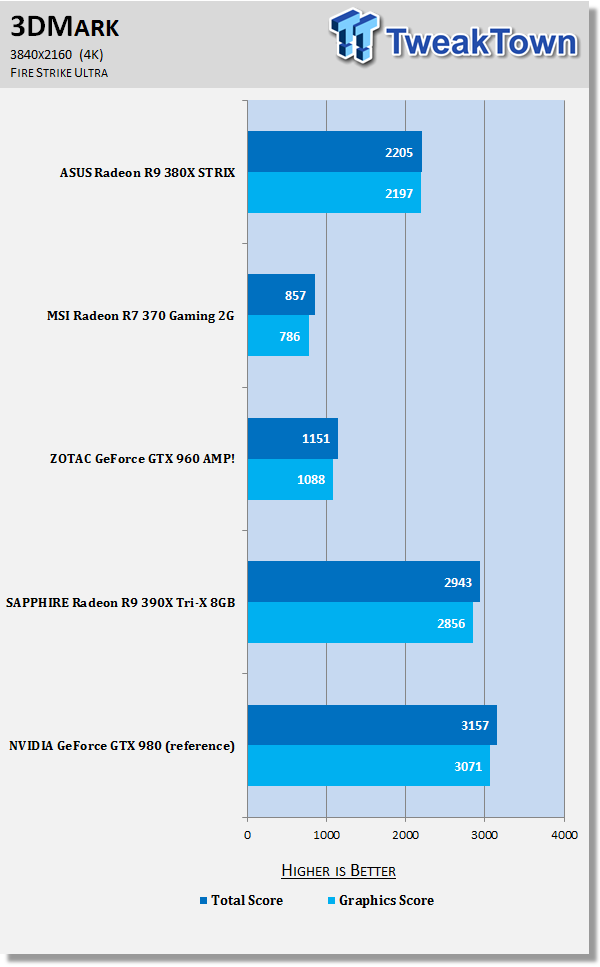
Heaven - 1080p
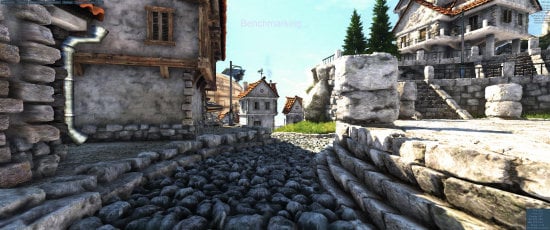
Heaven is a GPU intensive benchmark that really pushes your silicon to its limits. It's another favorite of ours as it has some great scaling for multi-GPU testing, and it's great for getting your GPU to 100% for power and noise testing.
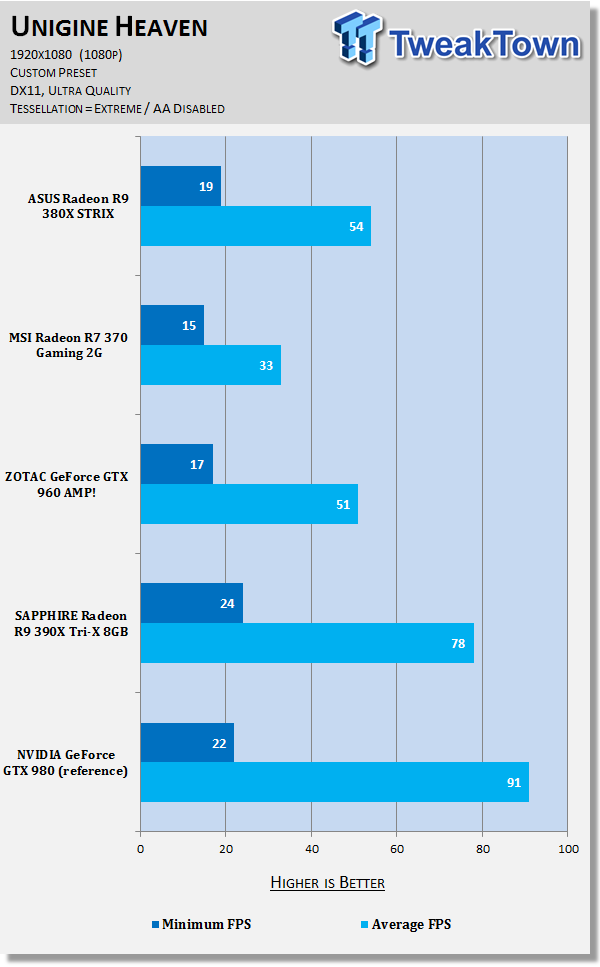
Heaven - 1440p
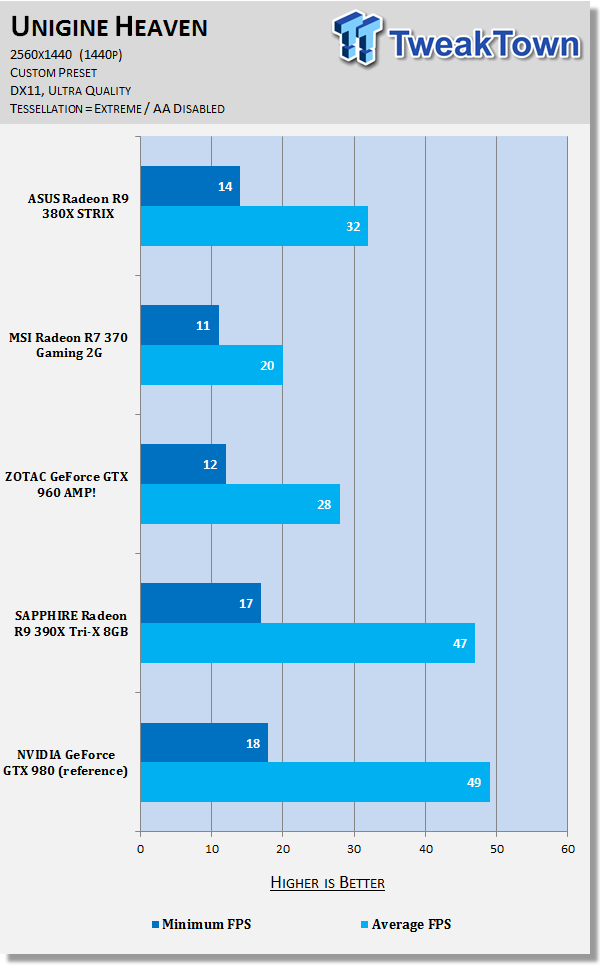
Heaven - 4K (3840x2160)
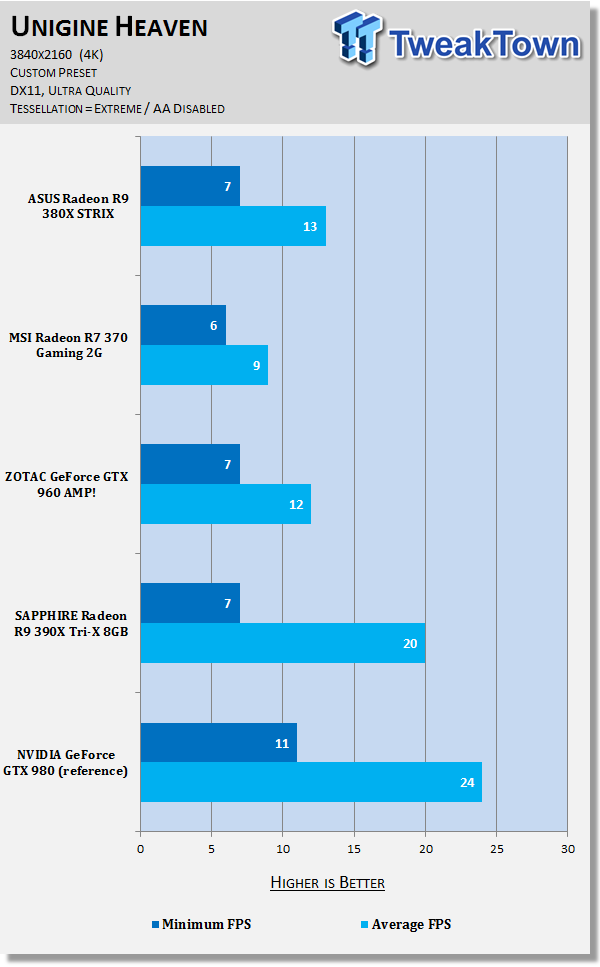
Heaven - UltraWide (3440x1440)
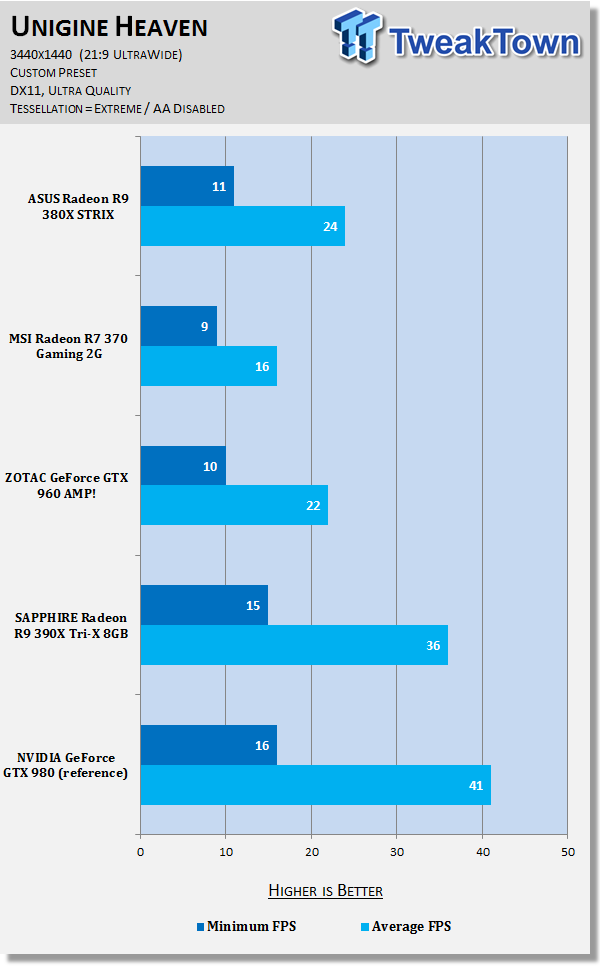
The first benchmark out of the gate has the R9 380X STRIX performing well, beating the GTX 960 in 3DMark at 1080p.
In Heaven, the ASUS Radeon R9 380X STRIX takes swipes at the GTX 960 and wins - with 54FPS average versus 51FPS. It's still a decent distance behind the R9 390X, of course.
Kicking things up to 2560x1440, we find the ASUS Radeon R9 380X hitting its stride, killing the GTX 960 in 3DMark. Things begin to get tighter between the GTX 960 and R9 380X STRIX.
4K is a resolution that is hard on any mid-range card - heck, even the flagship GPUs - but the R9 380X STRIX handles it well in 3DMark. It easily beats the GTX 960 (2GB version, so we're seeing a bigger limitation on the framebuffer here obviously) without a problem.
Benchmarks - 1080p
Battlefield 4 @ 1080p
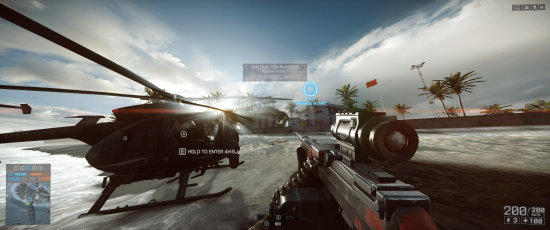
Battlefield 4 makes great use of DICE's incredible Frostbite 3 engine, with some great dynamic destructible environments in both the single-player and multiplayer sides of the game. The same engine has been deployed into many other games made by publisher EA, such as the new Need for Speed, and Mirror's Edge Catalyst.
You can buy Battlefield 4 at Amazon.
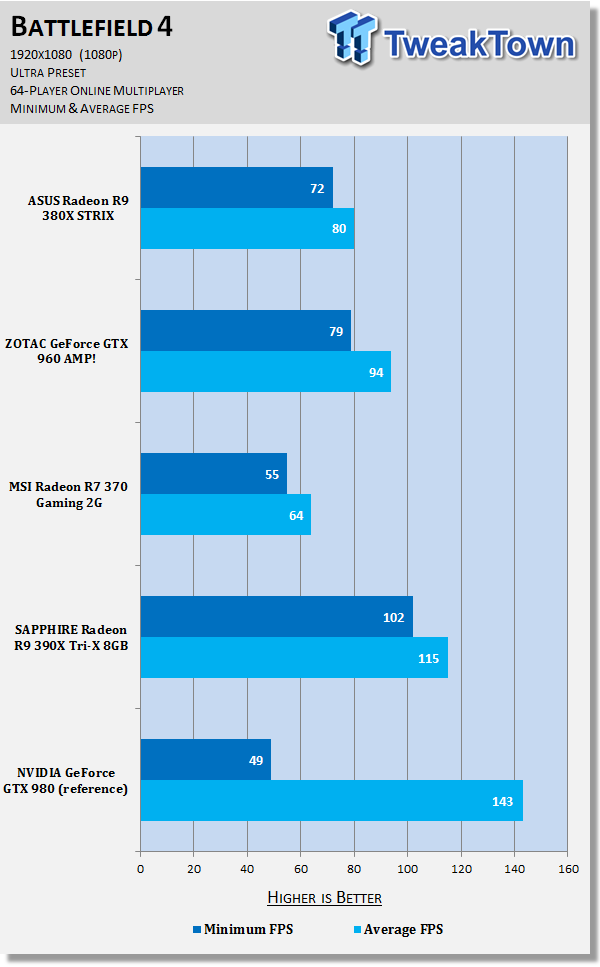
Grand Theft Auto V @ 1080p
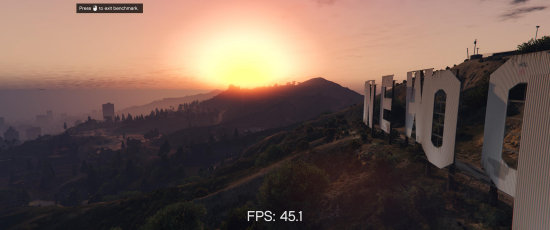
Grand Theft Auto V is one of the best looking open-world games on the market, with Rockstar Games making great use of the power of the PC by offering an optional first-person mode, and the huge upgrade in graphics over its console counterparts.
You can buy Grand Theft Auto V at Amazon.
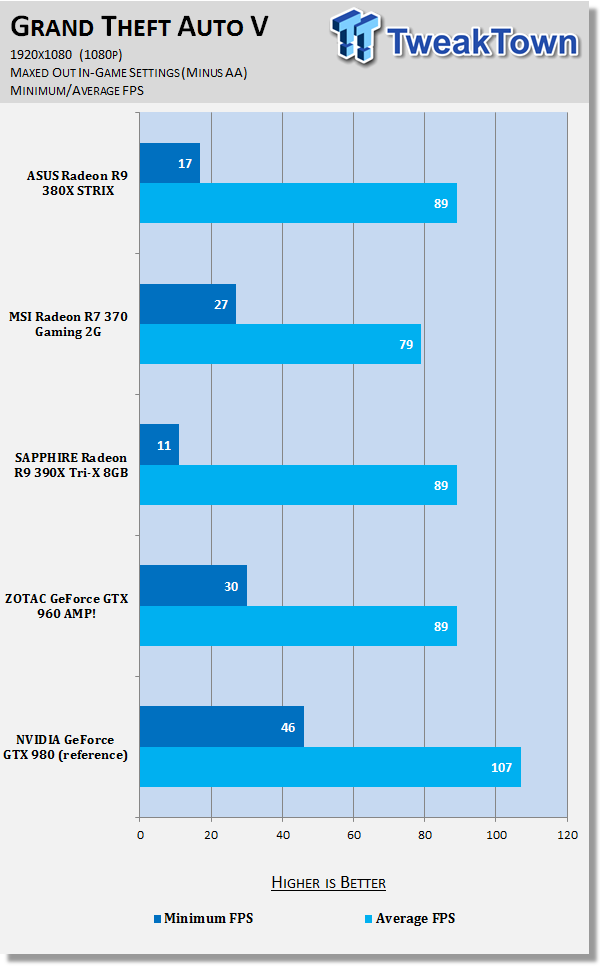
GRID Autosport @ 1080p
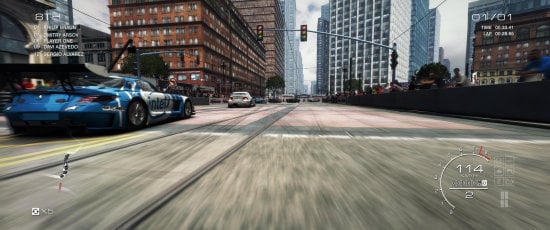
GRID Autosport is powered by Codemasters' own in-house 'EGO 3.0' engine, and while it was released last year, it is still one of the best looking driving games on the market. This is in the face of Forza Motorsport 6, Project CARS, and other driving games. While it looks great, it also runs beautifully even on modest hardware.
You can buy GRID Autosport at Amazon, and you can read our full review here.
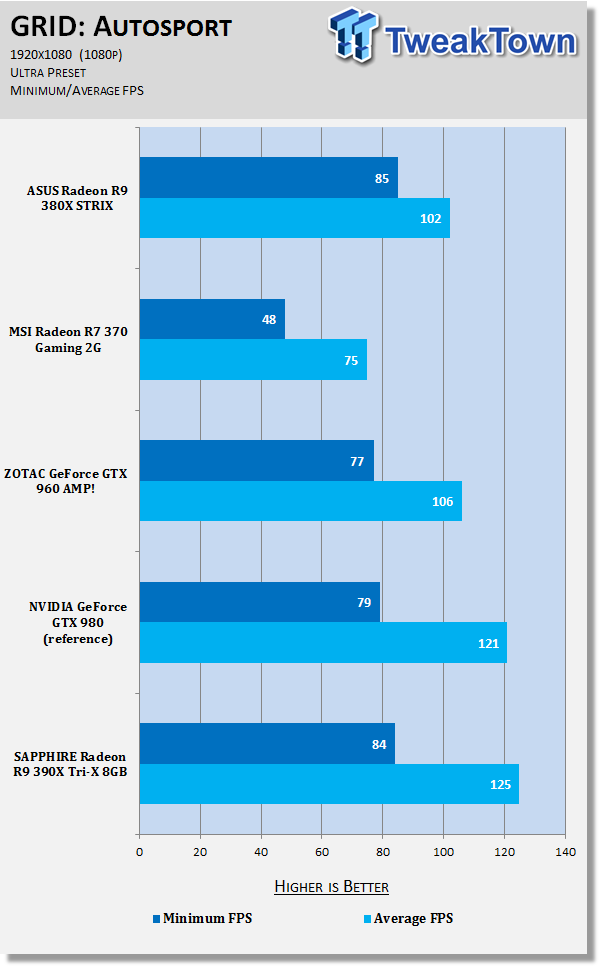
Metro: Last Light Redux @ 1080p
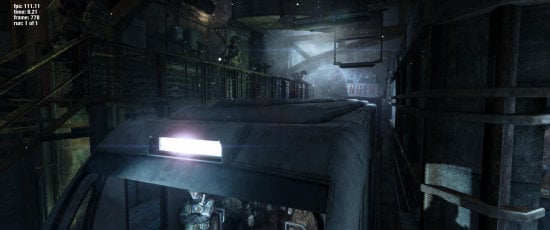
We recently changed over to Metro: Last Light Redux, with developer 4A Games making the Redux version of Metro: Last Light the 'definitive' version of the game. Redux had a fresh coat of paint on the already impressive 4A Engine, and it really pushes our GPUs to their limits.
You can buy Metro: Last Light Redux at Amazon.
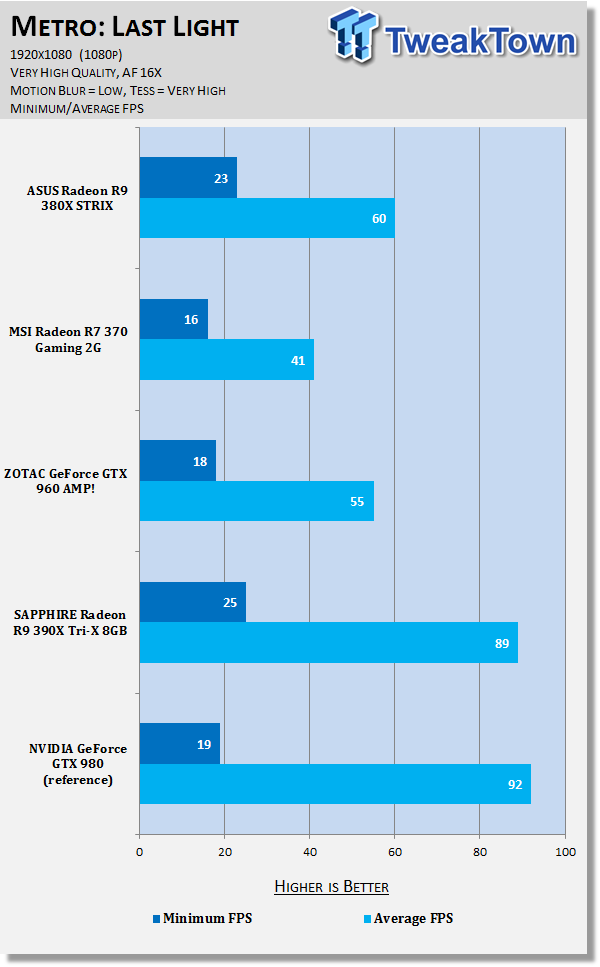
Middle-earth: Shadow of Mordor @ 1080p
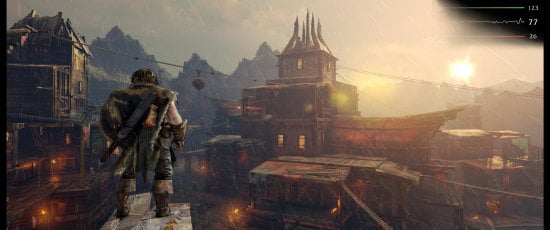
Middle-earth: Shadow of Mordor is one of the most graphically intensive games we test, with Monolith using their own Lithtech engine to power the game. When cranked up to maximum detail, it will chew through your GPU and its VRAM like it's nothing.
You can buy Middle-earth: Shadow of Mordor at Amazon.
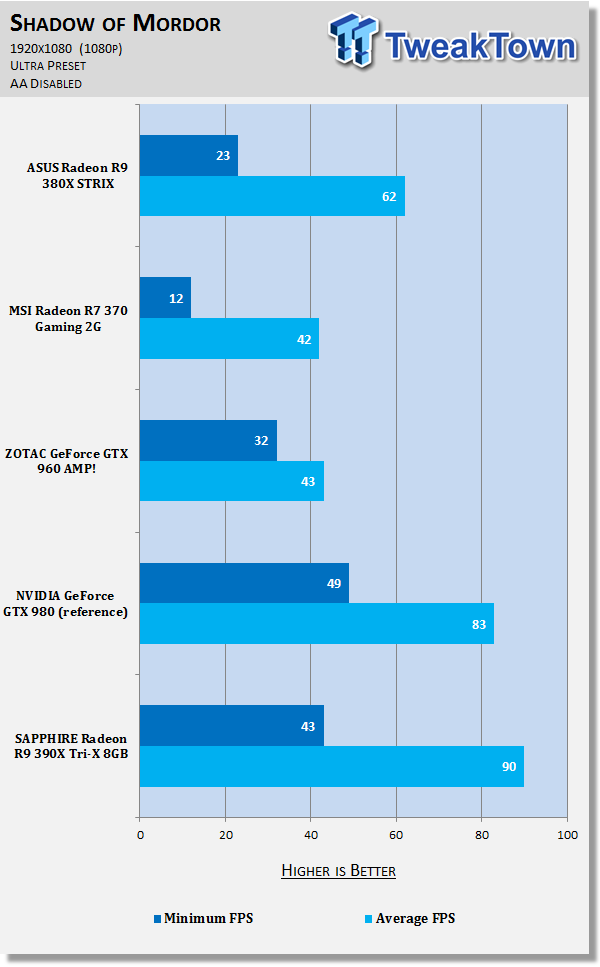
Thief @ 1080p

Thief has been around for quite a while now, with the latest version of the first-person stealth game powered by Epic Games' older Unreal Engine 3. While it's old, it has some great multi-GPU scaling that we use to test out our various GPU setups.
You can buy Thief at Amazon.
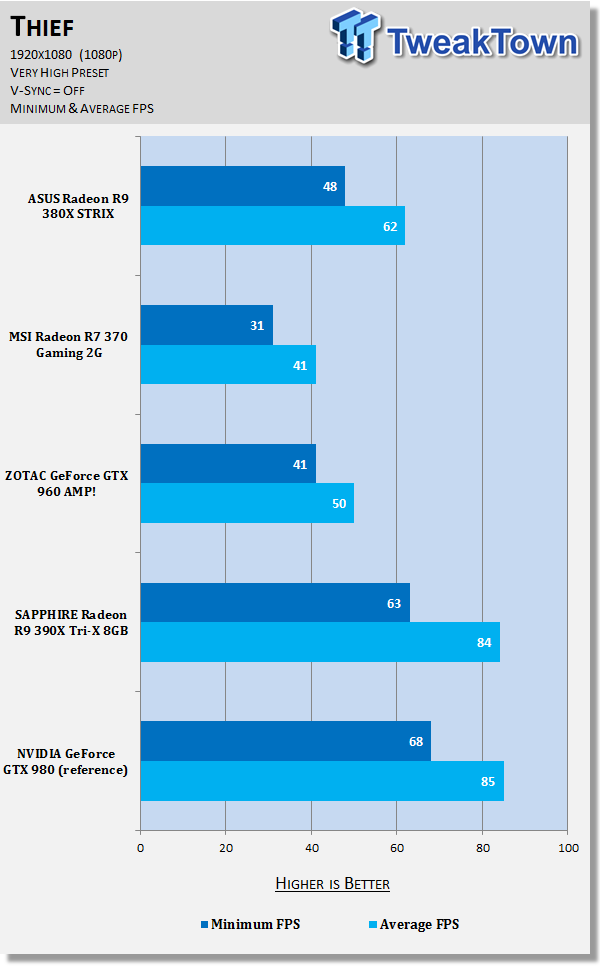
Tomb Raider @ 1080p

Tomb Raider is still such a gorgeous game, with developer Crystal Dynamics using their own 'Foundation' engine to build Lara Croft into the new world. One of the best parts about Tomb Raider is the absolutely stellar multi-GPU scaling, so this is an important test to see how well our NVIDIA GeForce SLI and AMD Radeon Crossfire setups scale.
You can buy Tomb Raider at Amazon.
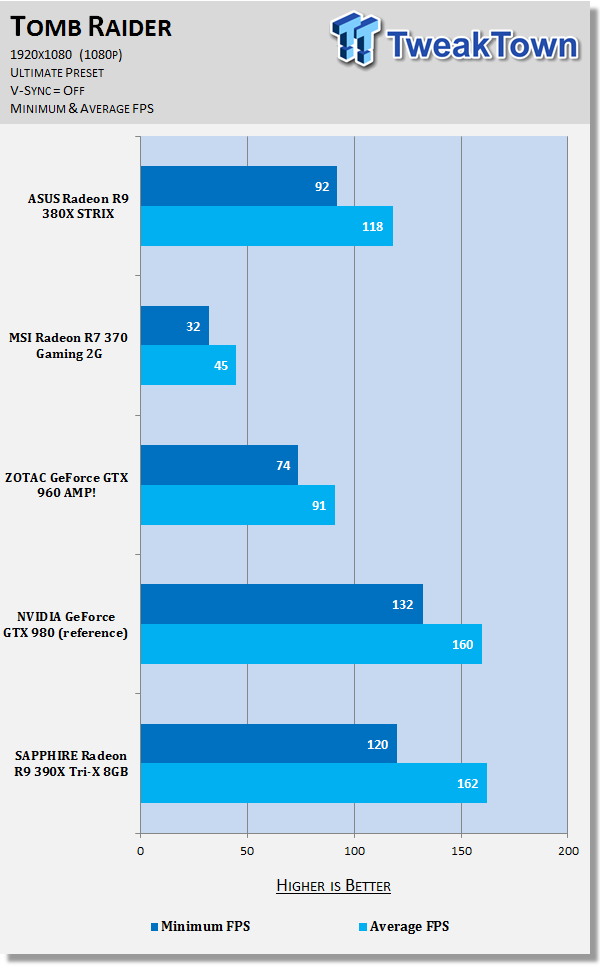
BioShock Infinite @ 1080p

Irrational Games built BioShock Infinite on a heavily modified version of Unreal Engine 3, putting it on the same playing field as Thief. It's still a great game to test on our various video cards, but this is one of the games we will soon be replacing as we get into the end of the year.
You can buy BioShock Infinite at Amazon.
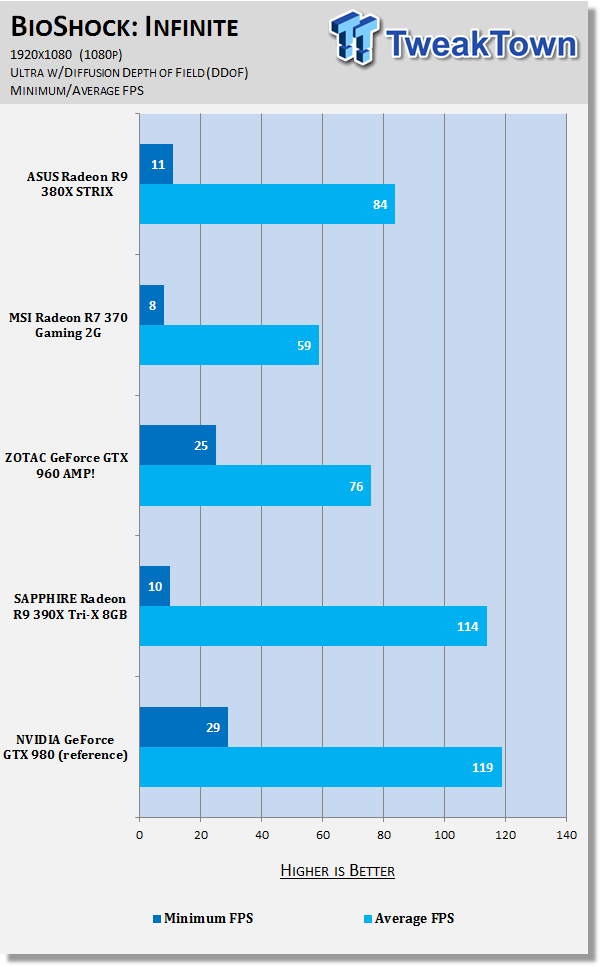
You can find our performance summary of all of our gaming tests later in the review.
Benchmarks - 1440p
Battlefield 4 @ 1440p

Battlefield 4 makes great use of DICE's incredible Frostbite 3 engine, with some great dynamic destructible environments in both the single-player and multiplayer sides of the game. The same engine has been deployed into many other games made by publisher EA, such as the new Need for Speed, and Mirror's Edge Catalyst.
You can buy Battlefield 4 at Amazon.
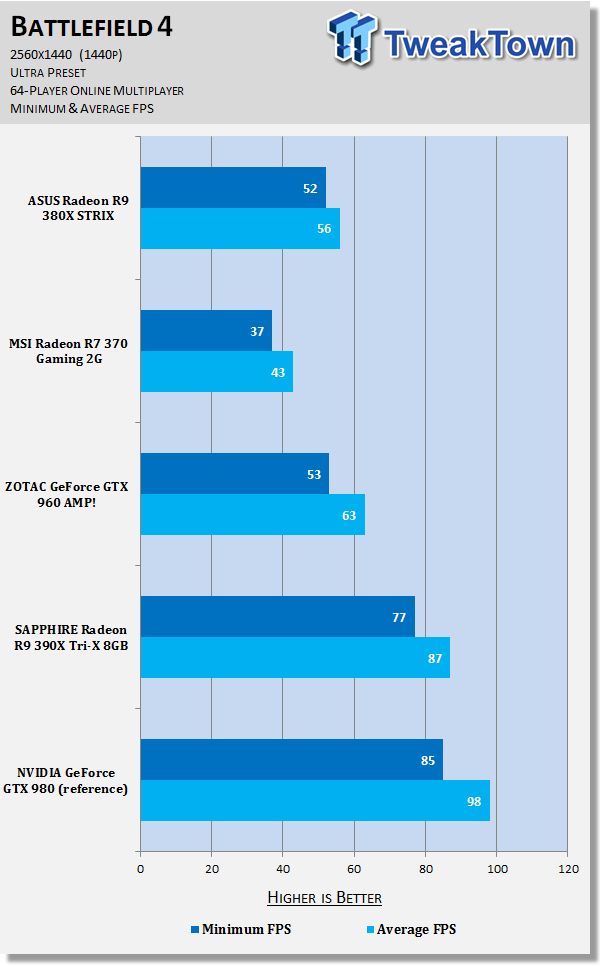
Grand Theft Auto V @ 1440p

Grand Theft Auto V is one of the best looking open-world games on the market, with Rockstar Games making great use of the power of the PC by offering an optional first-person mode, and the huge upgrade in graphics over its console counterparts.
You can buy Grand Theft Auto V at Amazon.
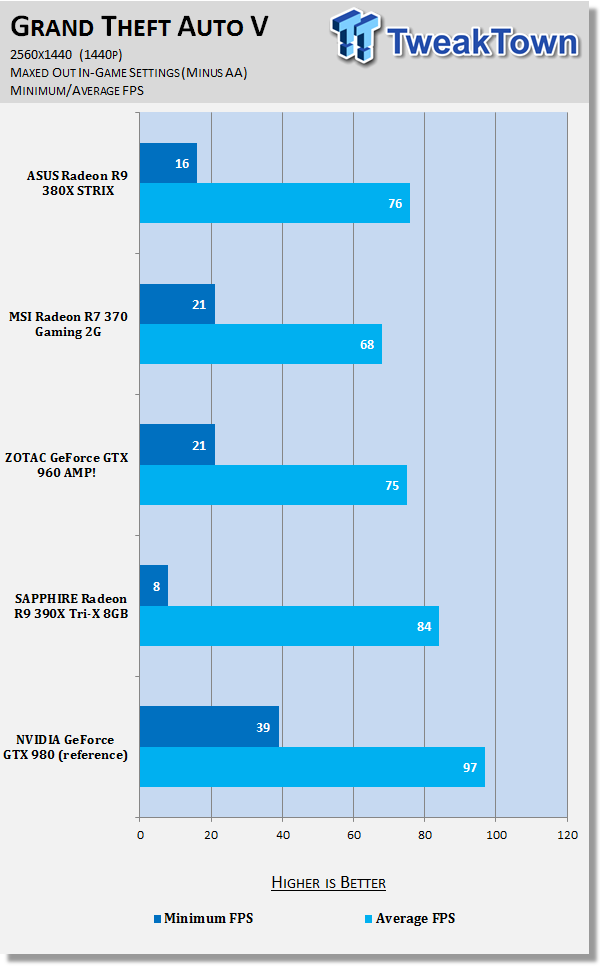
GRID Autosport @ 1440p

GRID Autosport is powered by Codemasters' own in-house 'EGO 3.0' engine, and while it was released last year, it is still one of the best looking driving games on the market. This is in the face of Forza Motorsport 6, Project CARS, and other driving games. While it looks great, it also runs beautifully even on modest hardware.
You can buy GRID Autosport at Amazon, and you can read our full review here.
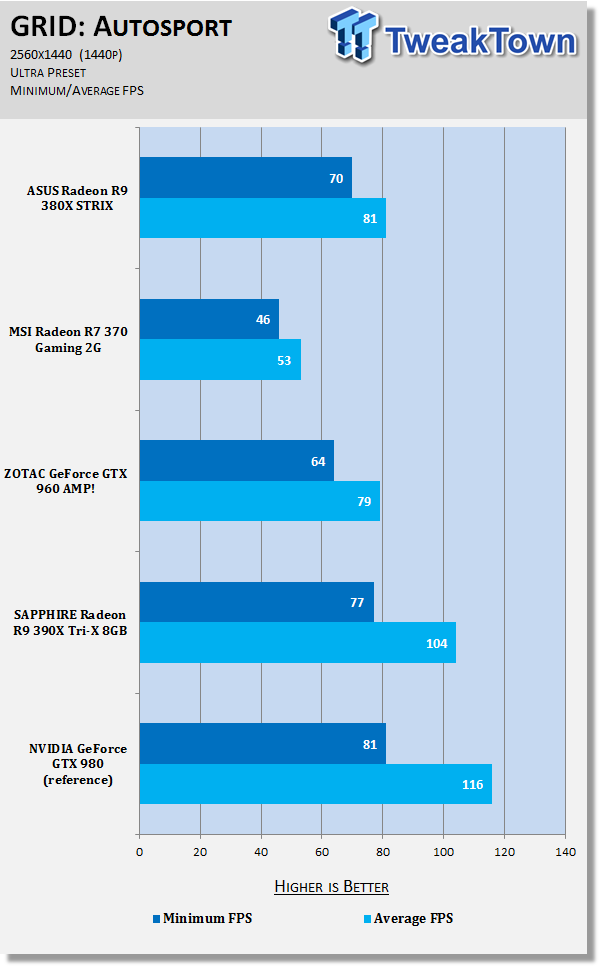
Metro: Last Light Redux @ 1440p

We recently changed over to Metro: Last Light Redux, with developer 4A Games making the Redux version of Metro: Last Light the 'definitive' version of the game. Redux had a fresh coat of paint on the already impressive 4A Engine, and it really pushes our GPUs to their limits.
You can buy Metro: Last Light Redux at Amazon.
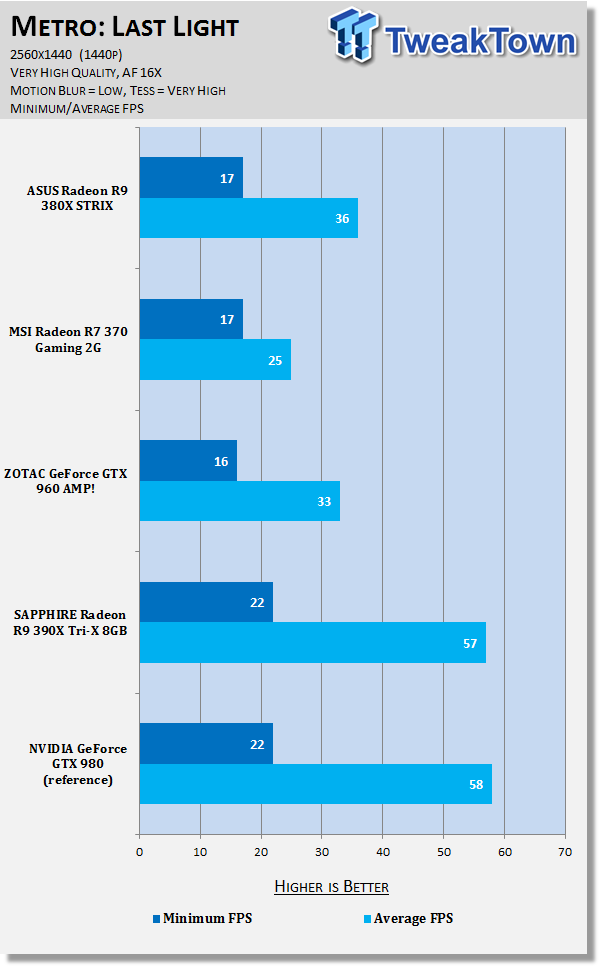
Middle-earth: Shadow of Mordor @ 1440p

Middle-earth: Shadow of Mordor is one of the most graphically intensive games we test, with Monolith using their own Lithtech engine to power the game. When cranked up to maximum detail, it will chew through your GPU and its VRAM like it's nothing.
You can buy Middle-earth: Shadow of Mordor at Amazon.
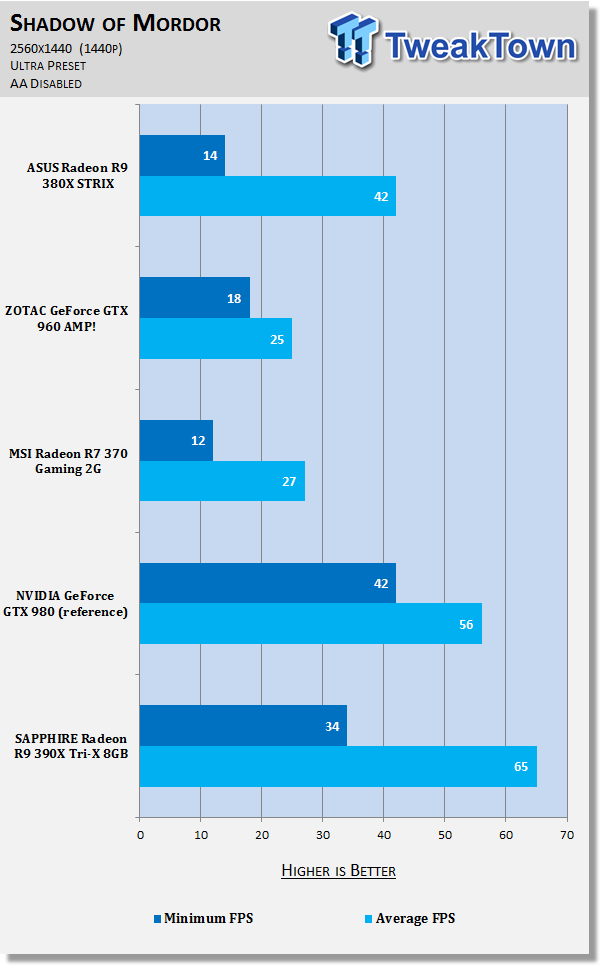
Thief @ 1440p

Thief has been around for quite a while now, with the latest version of the first-person stealth game powered by Epic Games' older Unreal Engine 3. While it's old, it has some great multi-GPU scaling that we use to test out our various GPU setups.
You can buy Thief at Amazon.
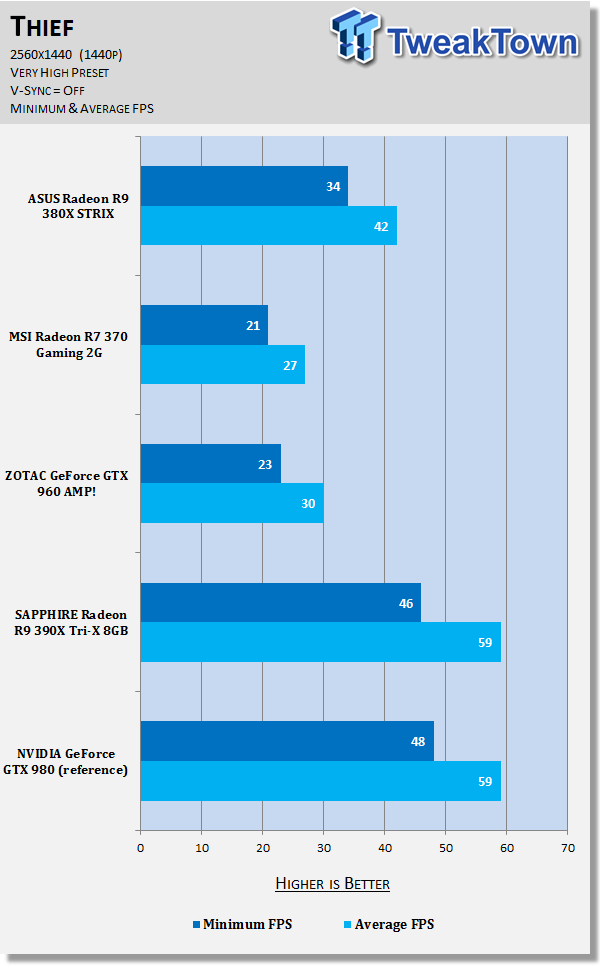
Tomb Raider @ 1440p

Tomb Raider is still such a gorgeous game, with developer Crystal Dynamics using their own 'Foundation' engine to build Lara Croft into the new world. One of the best parts about Tomb Raider is the absolutely stellar multi-GPU scaling, so this is an important test to see how well our NVIDIA GeForce SLI and AMD Radeon Crossfire setups scale.
You can buy Tomb Raider at Amazon.
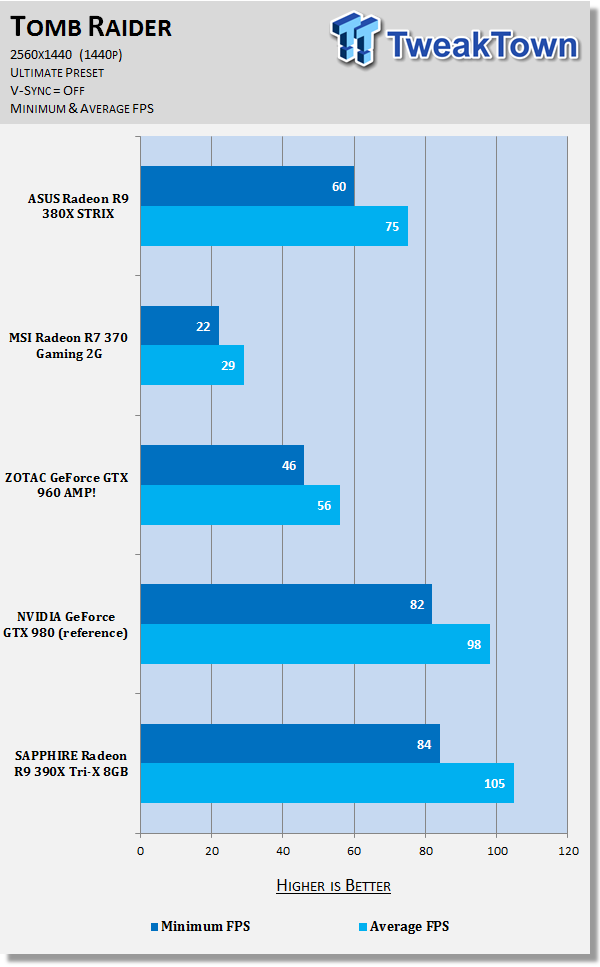
BioShock Infinite @ 1440p

Irrational Games built BioShock Infinite on a heavily modified version of Unreal Engine 3, putting it on the same playing field as Thief. It's still a great game to test on our various video cards, but this is one of the games we will soon be replacing as we get into the end of the year.
You can buy BioShock Infinite at Amazon.
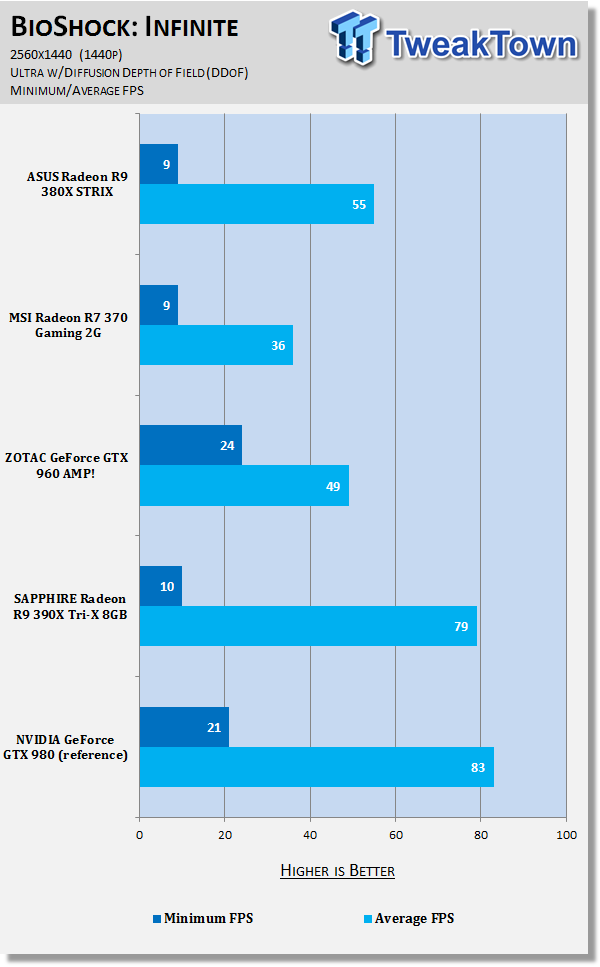
You can find our performance summary of all of our gaming tests later in the review.
Benchmarks - 3840x2160 4K
Battlefield 4 @ 4K (3840x2160)

Battlefield 4 makes great use of DICE's incredible Frostbite 3 engine, with some great dynamic destructible environments in both the single-player and multiplayer sides of the game. The same engine has been deployed into many other games made by publisher EA, such as the new Need for Speed, and Mirror's Edge Catalyst.
You can buy Battlefield 4 at Amazon.
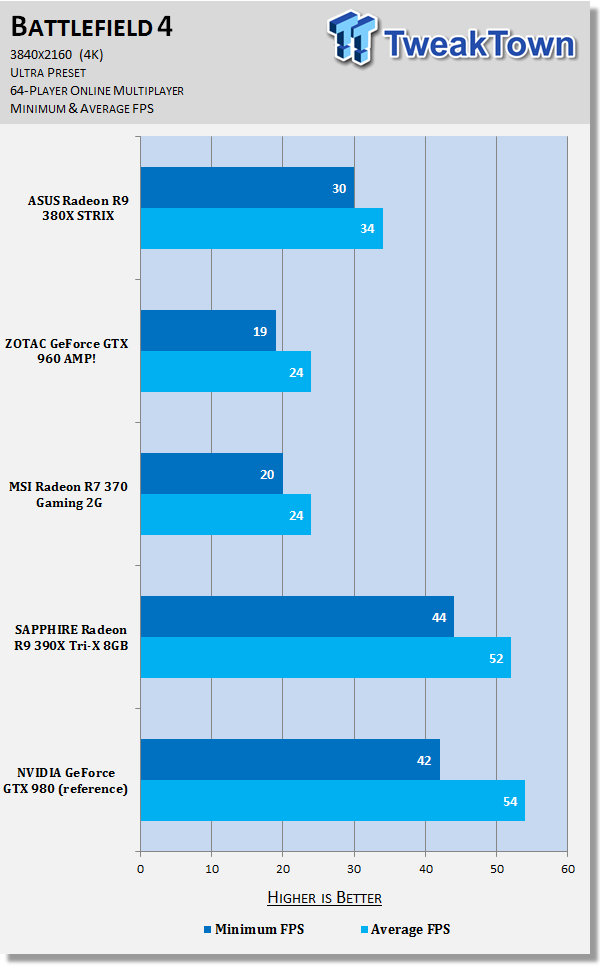
Grand Theft Auto V @ 4K (3840x2160)

Grand Theft Auto V is one of the best looking open-world games on the market, with Rockstar Games making great use of the power of the PC by offering an optional first-person mode, and the huge upgrade in graphics over its console counterparts.
You can buy Grand Theft Auto V at Amazon.
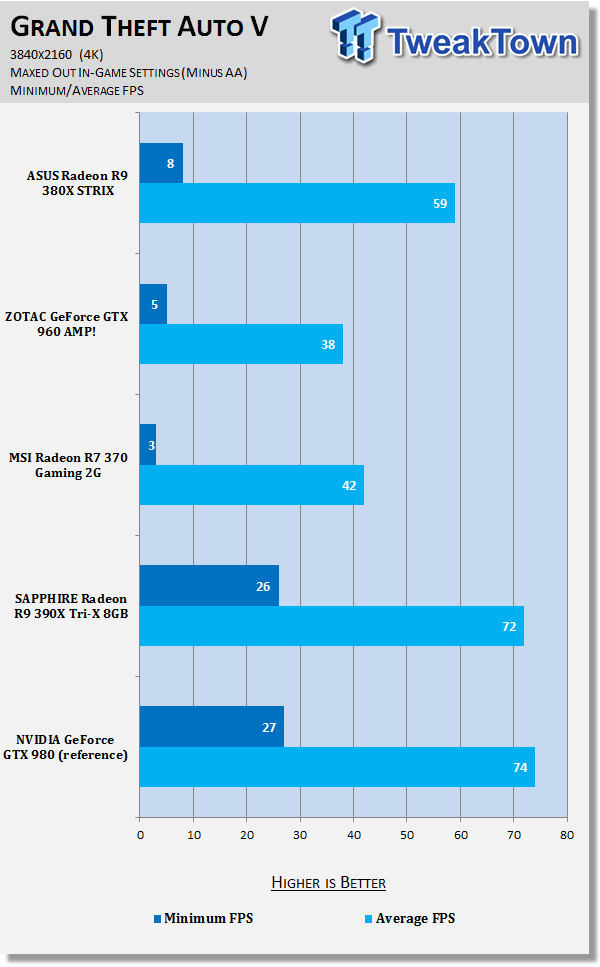
GRID Autosport @ 4K (3840x2160)

GRID Autosport is powered by Codemasters' own in-house 'EGO 3.0' engine, and while it was released last year, it is still one of the best looking driving games on the market. This is in the face of Forza Motorsport 6, Project CARS, and other driving games. While it looks great, it also runs beautifully even on modest hardware.
You can buy GRID Autosport at Amazon, and you can read our full review here.
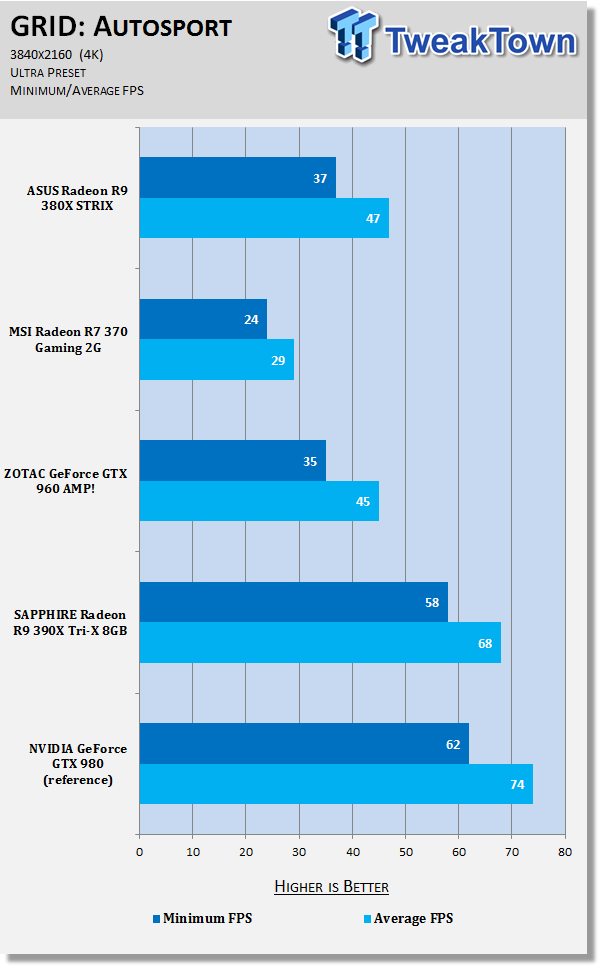
Metro: Last Light Redux @ 4K (3840x2160)

We recently changed over to Metro: Last Light Redux, with developer 4A Games making the Redux version of Metro: Last Light the 'definitive' version of the game. Redux had a fresh coat of paint on the already impressive 4A Engine, and it really pushes our GPUs to their limits.
You can buy Metro: Last Light Redux at Amazon.
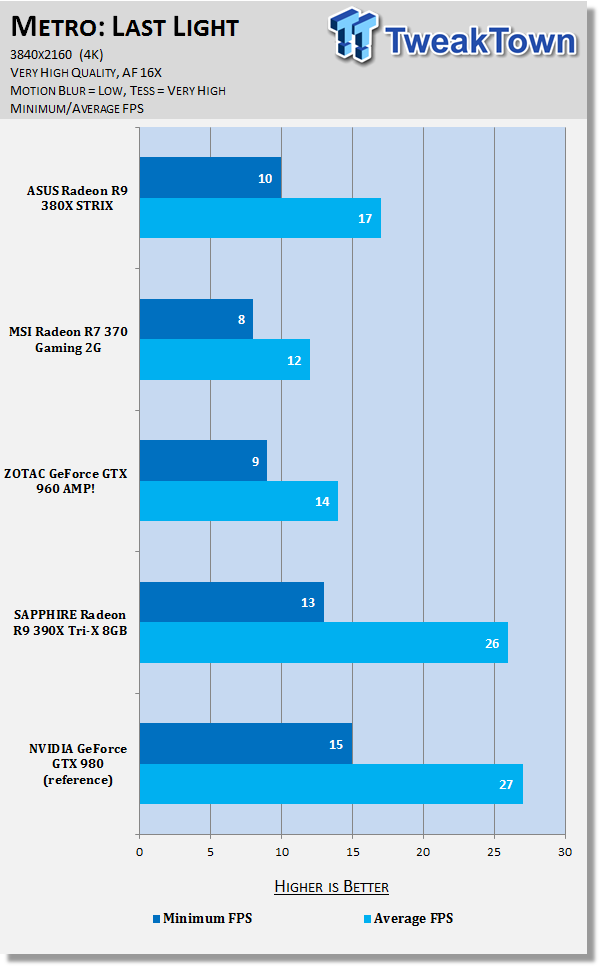
Middle-earth: Shadow of Mordor @ 4K (3840x2160)

Middle-earth: Shadow of Mordor is one of the most graphically intensive games we test, with Monolith using their own Lithtech engine to power the game. When cranked up to maximum detail, it will chew through your GPU and its VRAM like it's nothing.
You can buy Middle-earth: Shadow of Mordor at Amazon.
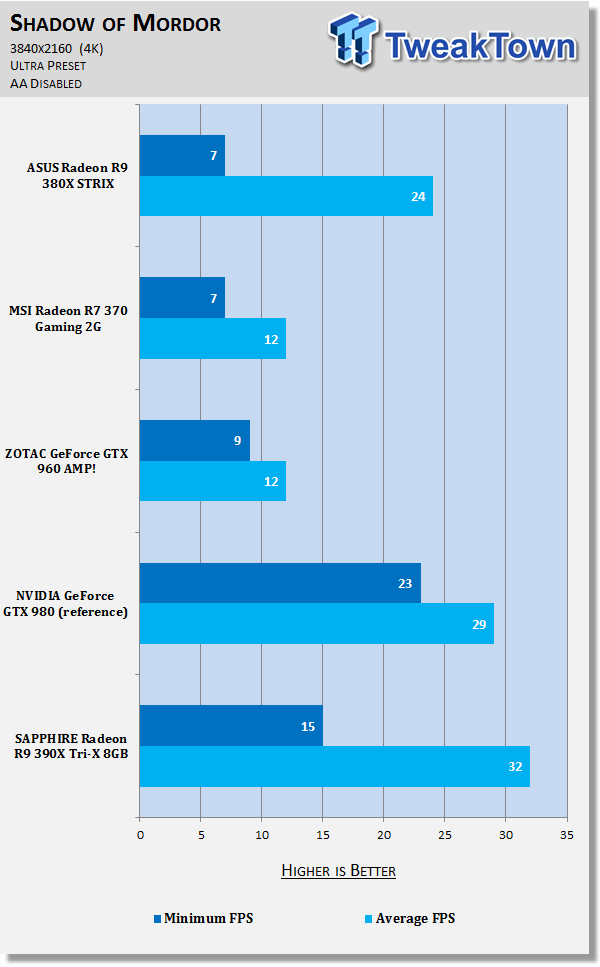
Thief @ 4K (3840x2160)

Thief has been around for quite a while now, with the latest version of the first-person stealth game powered by Epic Games' older Unreal Engine 3. While it's old, it has some great multi-GPU scaling that we use to test out our various GPU setups.
You can buy Thief at Amazon.
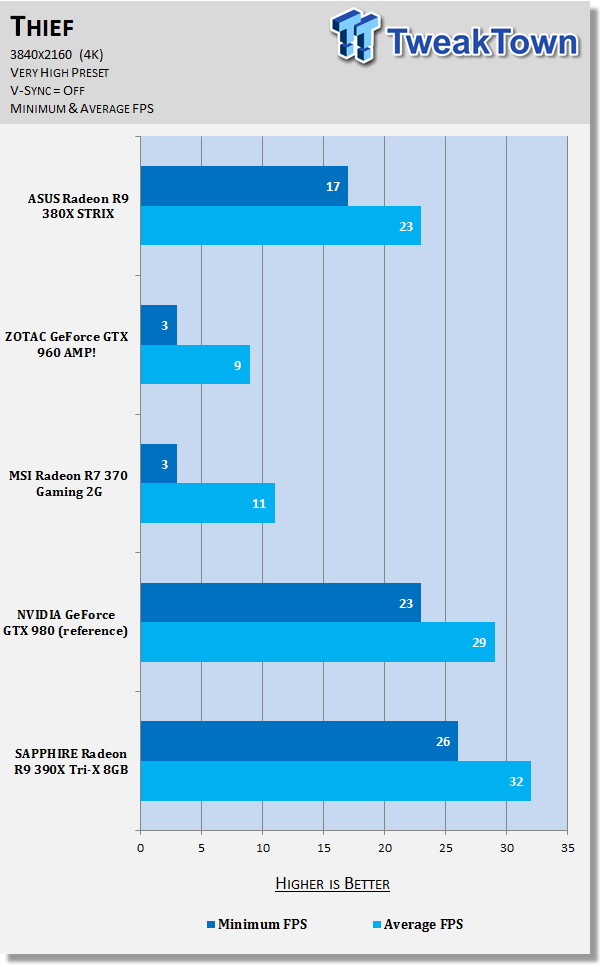
Tomb Raider @ 4K (3840x2160)

Tomb Raider is still such a gorgeous game, with developer Crystal Dynamics using their own 'Foundation' engine to build Lara Croft into the new world. One of the best parts about Tomb Raider is the absolutely stellar multi-GPU scaling, so this is an important test to see how well our NVIDIA GeForce SLI and AMD Radeon Crossfire setups scale.
You can buy Tomb Raider at Amazon.
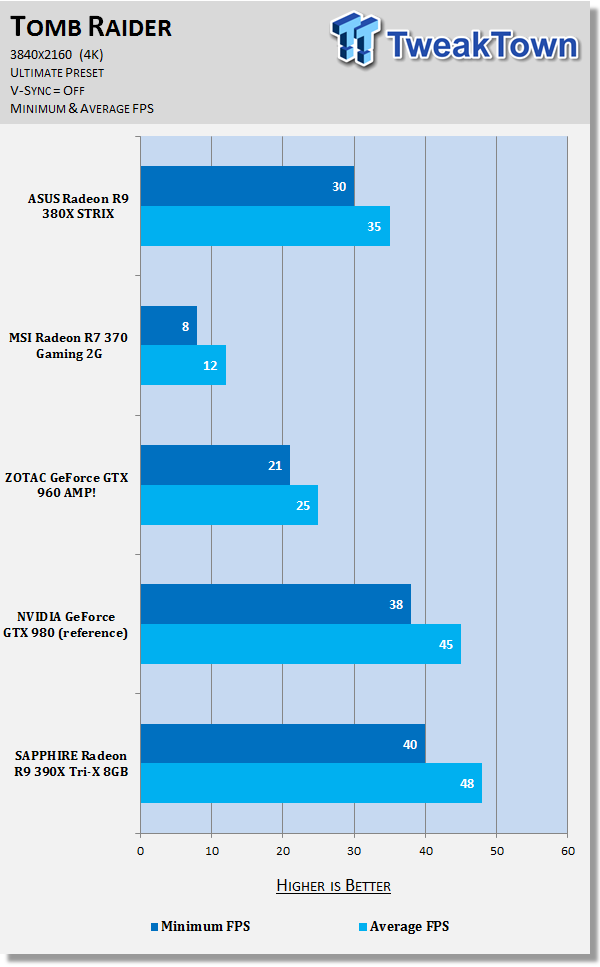
BioShock Infinite @ 4K (3840x2160)

Irrational Games built BioShock Infinite on a heavily modified version of Unreal Engine 3, putting it on the same playing field as Thief. It's still a great game to test on our various video cards, but this is one of the games we will soon be replacing as we get into the end of the year.
You can buy BioShock Infinite at Amazon.
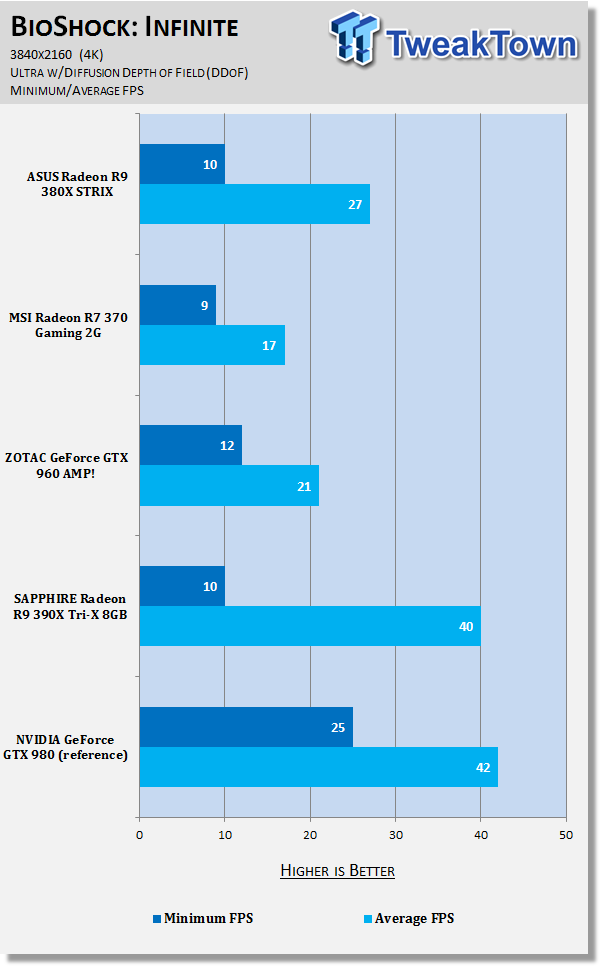
You can find our performance summary of all of our gaming tests later in the review.
Benchmarks - 3440x1440 UltraWide
Battlefield 4 @ UltraWide (3440x1440)

Battlefield 4 makes great use of DICE's incredible Frostbite 3 engine, with some great dynamic destructible environments in both the single-player and multiplayer sides of the game. The same engine has been deployed into many other games made by publisher EA, such as the new Need for Speed, and Mirror's Edge Catalyst.
You can buy Battlefield 4 at Amazon.
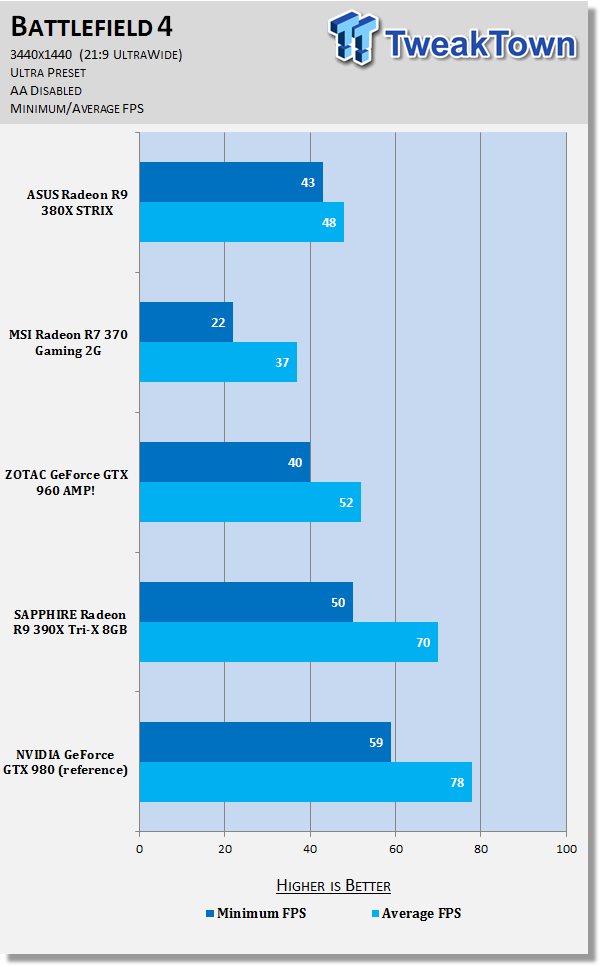
Grand Theft Auto V @ UltraWide (3440x1440)

Grand Theft Auto V is one of the best looking open-world games on the market, with Rockstar Games making great use of the power of the PC by offering an optional first-person mode, and the huge upgrade in graphics over its console counterparts.
You can buy Grand Theft Auto V at Amazon.
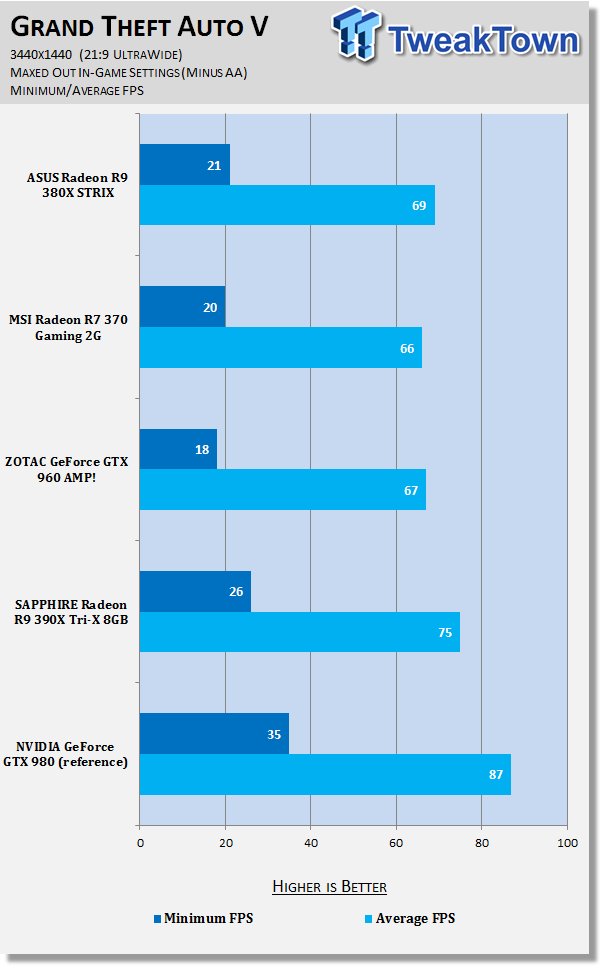
GRID Autosport @ UltraWide (3440x1440)

GRID Autosport is powered by Codemasters' own in-house 'EGO 3.0' engine, and while it was released last year, it is still one of the best looking driving games on the market. This is in the face of Forza Motorsport 6, Project CARS, and other driving games. While it looks great, it also runs beautifully even on modest hardware.
You can buy GRID Autosport at Amazon, and you can read our full review here.
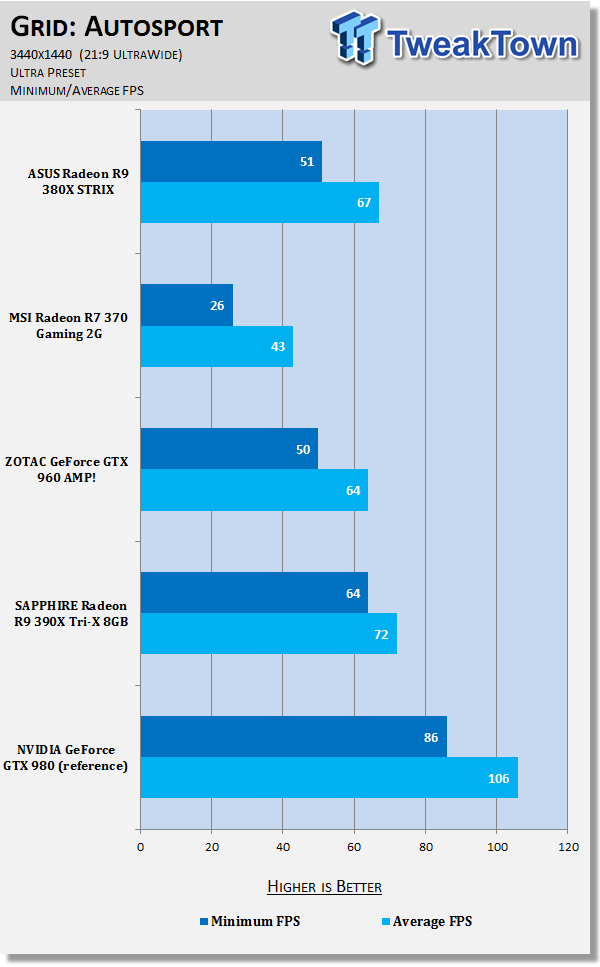
Metro: Last Light Redux @ UltraWide (3440x1440)

We recently changed over to Metro: Last Light Redux, with developer 4A Games making the Redux version of Metro: Last Light the 'definitive' version of the game. Redux had a fresh coat of paint on the already impressive 4A Engine, and it really pushes our GPUs to their limits.
You can buy Metro: Last Light Redux at Amazon.
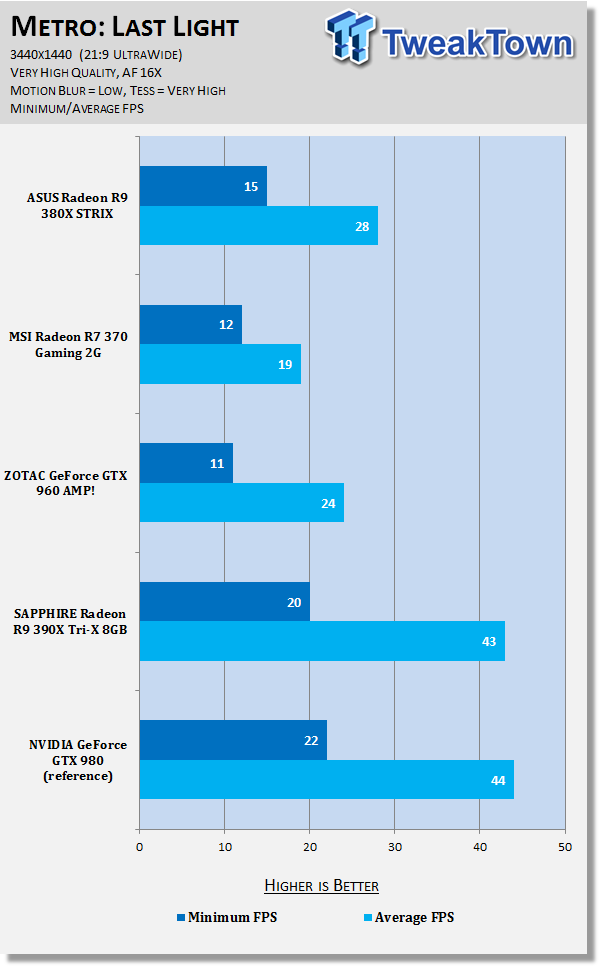
Middle-earth: Shadow of Mordor @ UltraWide (3440x1440)

Middle-earth: Shadow of Mordor is one of the most graphically intensive games we test, with Monolith using their own Lithtech engine to power the game. When cranked up to maximum detail, it will chew through your GPU and its VRAM like it's nothing.
You can buy Middle-earth: Shadow of Mordor at Amazon.
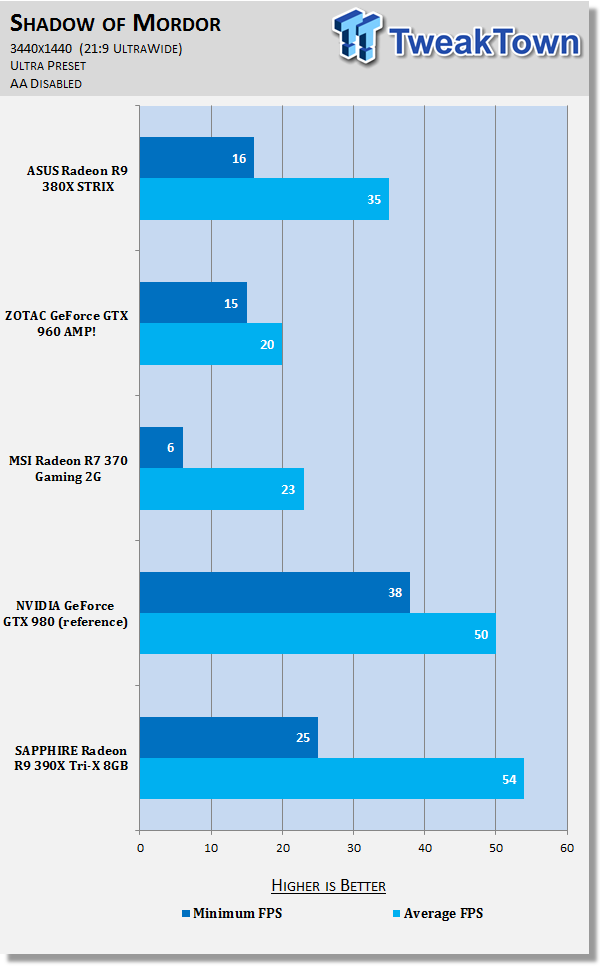
Thief @ UltraWide (3440x1440)

Thief has been around for quite a while now, with the latest version of the first-person stealth game powered by Epic Games' older Unreal Engine 3. While it's old, it has some great multi-GPU scaling that we use to test out our various GPU setups.
You can buy Thief at Amazon.
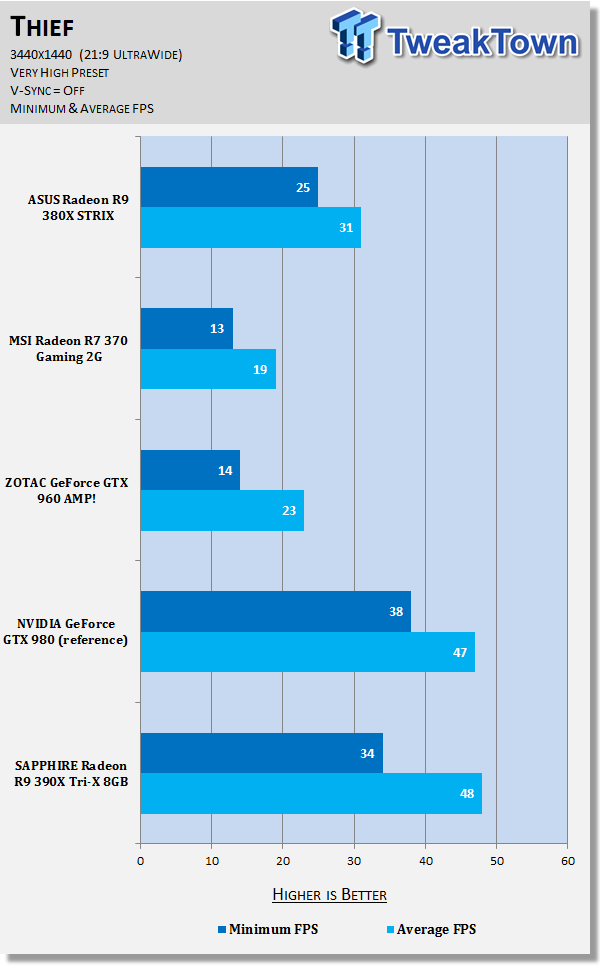
Tomb Raider @ UltraWide (3440x1440)

Tomb Raider is still such a gorgeous game, with developer Crystal Dynamics using their own 'Foundation' engine to build Lara Croft into the new world. One of the best parts about Tomb Raider is the absolutely stellar multi-GPU scaling, so this is an important test to see how well our NVIDIA GeForce SLI and AMD Radeon Crossfire setups scale.
You can buy Tomb Raider at Amazon.

BioShock Infinite @ UltraWide (3440x1440)

Irrational Games built BioShock Infinite on a heavily modified version of Unreal Engine 3, putting it on the same playing field as Thief. It's still a great game to test on our various video cards, but this is one of the games we will soon be replacing as we get into the end of the year.
You can buy BioShock Infinite at Amazon.
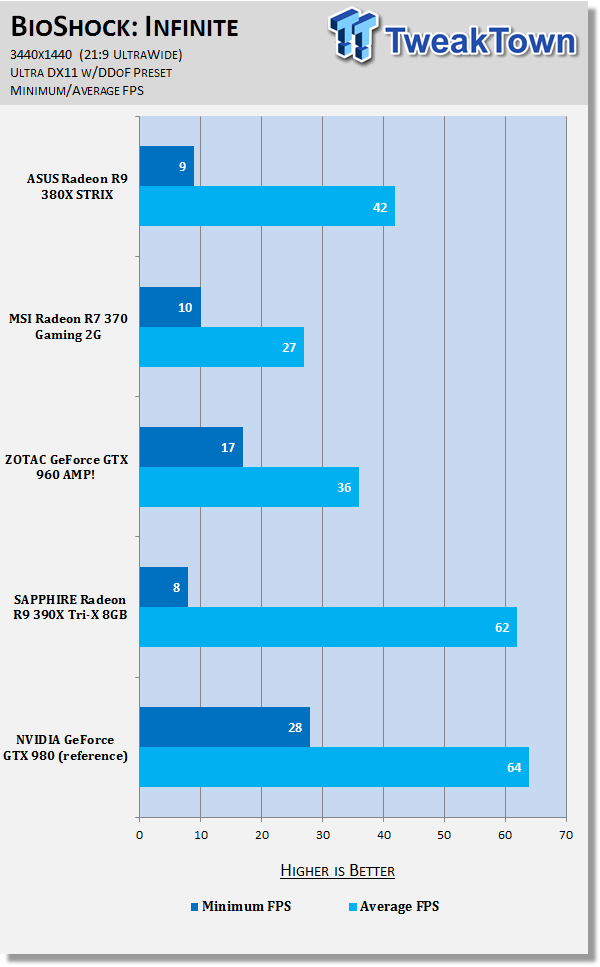
You can find our performance summary of all of our gaming tests later in the review.
Performance Summary
Is this AMD's Perfect GPU For $229?
AMD is aiming the Radeon R9 380X at 1080p and 1440p gaming, and surprisingly, more along the lines of 1440p gaming. The R9 380 and R9 380X are aimed at 1440p, while the lower-end Radeon R7 360 and R7 370 are the new 1080/MOBA cards from AMD.
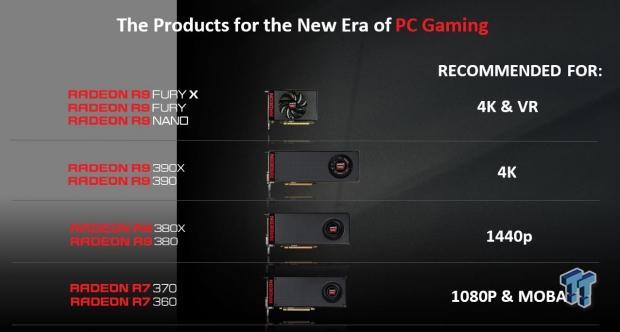
The ASUS Radeon R9 380X STRIX performs extremely well at 60FPS, and even at 1440p we noticed most of our games were running at 60FPS+. Even games like the newly released Star Wars: Battlefront and Fallout 4 will have no issues running at 1440p at 60FPS or so with most details on High/Ultra.
Performance at 1080p
This is where the ASUS Radeon R9 380X STRIX excels, and it's the resolution and market that AMD is aiming at with the Antigua XT-powered GPU. At 1080p, you can enjoy 60FPS+ in every game on the market without a problem, except a handful of games where you might need to knock just a couple of details down to maintain 60FPS minimum.
Performance at 1440p
Another market where the R9 380X is positioned is at 1440p, where we saw mostly 60FPS+, with some dips below the 60FPS mark. Again, you could drop some details down and maintain 60FPS without a problem at 2560x1440 on the ASUS Radeon R9 380X STRIX.
Performance at 4K (3840x2160)
The 4k performance was always going to be questionable on a card at this price, but we're still enjoying around 30FPS average in our games. In Battlefield 4 we saw 52FPS average at 4K, which was great while games like Shadow of Mordor, Thief, and Metro were all hovering at around the 30FPS mark.
Performance at UltraWide (3440x1440)
Now this is why we include UltraWide results at 3440x1440 in our video card tests because even a card at this price point can be used at 3440x1440 with great results. 3440x1440 is a great, and in my opinion, better alternative to 4K gaming. The ASUS Radeon R9 380X STRIX is capable of an average of 35FPS through these tests at 3440x1440, which isn't too bad at all.
Overclocking, Power Consumption & Sound Testing
Overclocking - Let's See How Far We Can Go
We didn't have much time to overclock our R9 380X STRIX, so expect us to do another article to follow up on this in the next week or so.
Power Consumption
Our entire Intel Core i7-5960X system with the ASUS Radeon R9 380X STRIX card consumed just 260W while in Heaven, and fluctuated up to around 270W during our testing on other games.
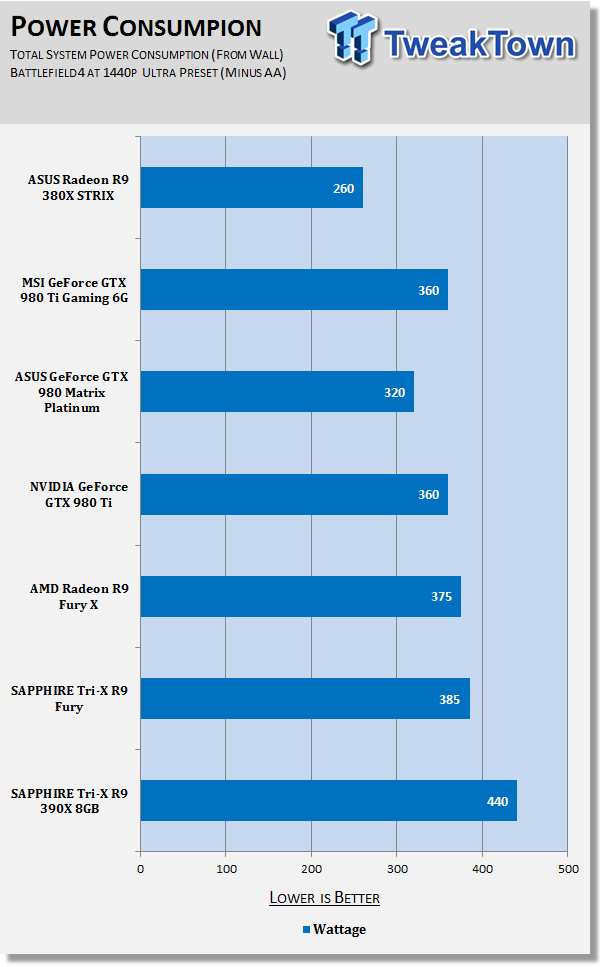
Sound Testing
Due to the limitation with the NDA time and my huge job of retesting all of our cards at all four resolutions because of our huge shift to Windows 10, I didn't have time to do the usual sound testing. But, the R9 380X STRIX was silent throughout all of our testing. Manually cranking the fans up will, of course, make it louder, and cooler - but there's no need to do this.
ASUS impressed us, like most other vendors now with 0dB fans, in their R9 380X STRIX.
What's Hot & What's Not
This is where you can fast forward to the final section of the review, and get a quick recap and points on the ASUS Radeon R9 380X STRIX.
What's Hot
Great Looks: This is the second card to feature dual cooling setups, giving you the choice of the stock air cooling (which is great), or to go down the water cooling route. ASUS does this with a card that isn't any thicker than a dual-slot GTX 980 Ti, too.

Awesome 1080p/1440p Performance: During all of our testing, we saw 60FPS+ in our gaming and benchmarking at 1080p. Cranking it up to 2560x1440 we saw close to 60FPS, which is great for a $239 card.
Silent Gaming: Any card that lets me game away while it doesn't make noise is a winner in this department. The ASUS Radeon R9 380X STRIX didn't make a peep during all of our testing, gaming, in all resolutions and tests. Great stuff.
Great Timing for the Holidays: Fallout 4. Star Wars: Battlefront. Just Cause 3. There are so many good games out right now, and this is a new GPU for the mainstream market that AMD should sell quite well in.
What's Not
Bad Timing: It's great timing for the holidays and all, but so many gamers already purchased the R9 380 or a GTX 960. If AMD had released this card 1-2 months ago, there would've been a huge increase in sales and a greater chunk of GPU market share scooped back from NVIDIA.
Final Thoughts
All in all, AMD has a great card in their hands with the Radeon R9 380X, and ASUS has done a great job with their spin on it with the STRIX card. If you're in the market for a new Radeon card that smashes 1080p and can be a formidable opponent at 1440p against NVIDIA's GeForce GTX 960, then you might want to check out the R9 380X.

4K gaming is still out of its reach, but we are talking about a $230 card here. 4K gaming is still a while away from being mainstream, where I think 4K gaming will hit that stride when $230 cards like the R9 380X can do it at 60FPS.
ASUS has impressed us yet again with the R9 380X STRIX, with the only lacking part of the card being the 2 x DVI ports. This is mainly AMD's fault, but I can see they're targeting mainstream users who might not have shifted up to DisplayPort-capable monitors just yet.
Wrapping things up, if you've been waiting for a new GPU to buy for your 1080p gaming, and you haven't purchased a card yet - the ASUS Radeon R9 380X STRIX is something that should be on your radar. It's silent, is capable of 1080p 60FPS+ gaming, and looks great, too.

